|
| Featured Article Archive 2008 |
|
|
| ~ December 8, 2008 ~ |
| Equestfest to Feature Tournament of Roses Parade Equestrian Acts at LA Equestrian Center |
| BURBANK, December 8, 2008 Equestfest, an exciting show featuring the 2009 Pasadena Tournament of Roses Parade equestrian participants, will come to the Los Angeles Equestrian Center Sunday, December 28, 2008. The action-packed show provides a rare opportunity to see the parade's equine acts up close in a wide variety of performances, including many not presented on the parade route. Equestfest 2008 features a Hats off to Entertainment theme, and, new this year, will include the Sons and Daughters of the Reel West act. Patrick Wayne, Wyatt McCrea, Kiki Ebsen, Jennifer Rogers-Etcheverry, Thomas Rowan, and Julie Ashley, relatives of some of America's most beloved entertainers, are all slated to appear with the Sons and Daughters of the Reel West. Equestfest will host an entertaining line up of equestrian talent from the famous parade, in addition to providing a fun, family-friendly afternoon of exhibits, horsemanship activities, music and food. The 2008 show will include roping acts, jousting demonstrations, precision riding teams, mini donkeys, and the California State Firefighters Association. The ever-popular All American Cowgirl Chicks and Medieval Times are among the many acts scheduled for the show. Equestfest will run from 11:00 am to 3:00 pm (rain or shine) at the LA Equestrian Center's covered Equidome and surrounding area. Tickets are $10 per person (children under 5 are free) and can be purchased prior to the show online at www.sharpseating.com or by calling 626-795-4171. Tickets also will be on sale the day of the event. The LA Equestrian Center is located at 480 Riverside Drive in Burbank. There is parking fee of $5 per car. Fore more information, visit our Calendar of Events or contact Joanne Asman at 818-842-8444 or by E-mail ; Barbara Price at 760-751-2768 or by E-mail . |
|
| ~ November 17, 2008 ~ |
| Ten Plants to Watch Out For By: Tori Zdeb |
| As caretakers and guardians of our beloved hoofed friends, we humans all challenge ourselves to keep our pastures clean cut of hazards, including harmful vegetation. The good news is, most horses will pick their regular feed over bitter poisons, and if they do sample a taste, it takes quite a bit to floor a half ton animal. The bad news is, horses are delicate creatures despite their size, and we all know they have a rather inconvenient and often costly tendency to find the only thing on a hundred acres that will hurt them. While most innocent nibbles of curiosity are harmless, some plants found in our area have been proven deadly. Here are a few you may want to keep an eye open for. |
|
OLEANDER:
Many of you will recognize Oleander from your neighborhoods and perhaps your own yards. Oleander is one of the more common shrubs found on Southern California , and are often used decoratively or in hedges. You may be surprised to know, despite its disarmingly beautiful flowers and startling abundance, as few as thirty leaves are needed to kill a horse. It takes anywhere from eight to twenty four hours to take complete effect. Symptoms include erratic heartbeat, profuse sweating, and labored breathing. |
| |
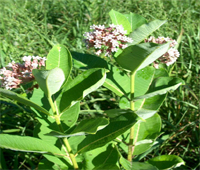 |
MILKWEED:
This is the least dangerous of the ten plants. As a rule, horses avoid the tastes of plants such as most milkweeds. However, it is a common pasture weed, and can often be found in hay fields. When the hay is cut, so is the milkweed, which does not lose its toxic qualities when dried. Symptoms include lack of coordination, seizures, and colic. May result in death after 1 to 3 days if consumed in large quantities. |
| |
 |
OAK:
When trail riding in southern California , the most likely place to find shade to rest in is probably under a mighty oak. Resting is fine in the shade, but grazing may not be such a good idea. Both the leaves and acorns are toxic. Small quantities are not usually harmful, but there is no known antidote. Better safe than sorry.fence off your Oak trees. |
| |
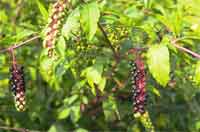 |
POKEWEED:
This plant is rarely found in the wild, but is commonly used as an ornamental plant in southern California . The roots are the most deadly part of the plant, although most horse poisonings come from eating fresh leaves. Symptoms include colic, diarrhea and respiratory failure. If a lethal dose is consumed, dyspnea and paralysis may be followed by fatality. |
| |
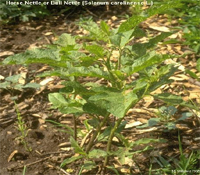 |
HORSE NETTLE:
This species of nightshade is found fairly commonly in many neglected spaces including vacant lots. The leaves and green fruits are especially toxic, although wilted leaves have proven deadly as well. Death may occur suddenly or as much as 3 days from onset of symptoms. Signs of poisoning include trembling, dilated pupils, in coordination and sometimes coma. |
| |
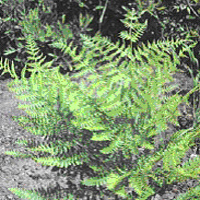 |
BRACKEN FERN:
Commonly found in the wilderness and sometimes in the front yards of California , Bracken Fern is an extremely uncomfortable plant for your horse to get his jaws on. Although not typically deadly, ingestion causes a thiamin deficiency which results in loss of coordination, muscle tremors and eventually paralysis. The toxin is accumulative, and without treatment Bracken Fern poisoning may be fatal anywhere from 30-60 days after symptoms appear. With treatment a full recovery may be made. |
| |
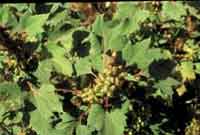 |
COCKLEBUR:
If you have a longhaired dog who likes to roam towards the end of summer, you know how pesky cockleburs can be. Apart from sticking like Velcro, the seeds and seedlings are toxic when ingested. This plant is palatable when young, but tastiness as well as toxicity decrease with maturity. Symptoms include reduced responses, muscle weakness, and rapid weak pulse after 2-24 hours. |
| |
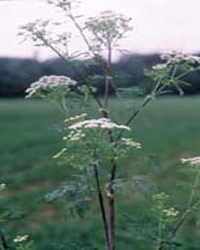 |
HEMLOCK (Poison and Water)
Although not as common in southern California as many of the other ten, Hemlock can be deadly in fairly small amounts. Water Hemlock can kill within 15 minutes after first abnormalities are noticed. Symptoms include uneasiness, frothing of the mouth and convulsions. Poison hemlock (shown above) is less dangerous as it is less palatable, and only attractive as a young shoot. However it is easy to mistake it for anise, a plant found commonly on southern California trails. Signs include nervousness, in coordination and abdominal pain. |
| |
 |
JIMSON WEED (locoweed)
This common weed can mainly be found in fields or on the side of the road. Before I knew what it was, I referred to it as "B.O. plant" due to its disgusting odor. Luckily, this plant tastes about as bad as it smells. Unluckily, if accidentally ingested the effects are such as you would expect from a plant with such a nasty personality. Rapid but weak pulse, pupil dilation, erratic movements and nervousness are some Common symptoms. If untreated, death may occur. |
| |
 |
MUSTARD (Wild and Field)
Here's the one I found most surprising. If you've ever ventured outside your house I can give a 99% guarantee you've seen mustard plants growing. The plant is not harmful in its infant state; however seeds and stems may be toxic. Mustard poisoning may cause birth defects in foals, and is usually characterized by photosensitivity, anorexia and gut discomfort. There is no cure for mustard poisoning but it takes quite a bit of just the right parts of the plant to be cause for concern. |
Remember, the best way to keep a horse safe is to prevent them from getting into trouble. Keep pastures clear of these plants, and continue to check them year round. A balanced diet is all a good step towards prevention as horses are less likely to stray from normal foods if they have no mineral deficiencies and are full. If poisoning does occur, call your veterinarian immediately and take the steps necessary to make the horse more comfortable until help arrives. If you'd like to know more, visit my sources:
http://ohioline.osu.edu/b762/b762_24.html
http://www.horsecareonline.net/ToxicPlants.htm
http://www.whmentors.org/saf/poison.html
http://www.omafra.gov.on.ca/english/livestock/dairy/facts/87-016.htm |
|
|
|
A story from Alessandra Deerinck DVM
|
It is a hot summer morning and I am about two minutes away from “Dances With Horses”, the ranch where my horse lives. Rosalie is a seven year old chestnut thoroughbred mare from the track. For the past year I have been training her using the Carolyn Resnick Method also known as “Liberty Training”.
Carolyn learned how horses communicate in a wild herd and translated what she observed into interactions that horses and humans can share and understand.
Rosalie is now well versed in Carolyn’s Method and I have recently started to ride her. Each time we have done this, it has been a great experience for both of us and she has never shown any kind of resistance. We always ride in a large arena and a few times have done so bridleless. Our training program has a regular but very flexible schedule.
The most important thing is to be constantly aware of the relationship you have with the horse you are working with and choose your actions accordingly.
Carolyn’s Method allows you and your horse to build a relationship with a solid foundation and a system of communication you can both depend on. This leads to teamwork, where the human leads and the horse follows as if it’s his own idea. Because of this connection you then share, every area of work whether on the ground or in the saddle is accomplished effortlessly. From there, you can really tune your riding skills regardless of the equestrian discipline you choose to challenge yourself and your horse with.
When I arrive, Rosalie is eating her breakfast and doesn’t openly acknowledge my presence. So I go about my routine, getting her feed and getting the tack ready, waiting to interact with her when she is more interested in our time together. I only have to wait a few minutes and she is hanging out on the side of her corral looking for me.
We always start each day by spending a few minutes together without interacting but giving each other time to express our state of mind. This time is very valuable for our performance together, whatever that may be.
Then we begin communicating with each other through what Carolyn calls the Waterhole Rituals. This is what horses do in their own communities in the wild. Regardless of the time they have been apart, they always pick up their communication again this way.
If Rosalie doesn’t show interest in following my lead, I use the Waterhole Rituals further to re-establish my leadership. When I feel she is connected to me, I know I can do almost anything and she will want to do it with me. The few minutes of warm-up time with the Rituals allow me to get connected with my horse so we can work in harmony from the beginning.
This past year has been a time of growth and change. My horse has gone from being a racehorse to learning to be part of a team that dances in harmony through any situation. I do not know where our limits are, we take new steps every day, finding new horizons, challenges and obstacles to jump together. Today may be learning the Spanish Walk or Piaffe together, tomorrow might be going out for the first time on a trail ride.
Today she looks like she is just waiting for me to start playing and so we do. After a few minutes of grooming I put the saddle on and lead her to the arena. We are connected. After a few minutes of working in hand and “single lining” (another part of Carolyn’s Method) I feel it is time to ride. Rosalie is relaxed and I want her to experience the enjoyment that I do.
I ride her for about fifteen minutes, then I dismount and longe her at walk, trot and canter. She is again following my lead and executing anything I ask of her. We do not need “turn out time”, “chasing” or exhausting longeing before working. Our state of connection creates the performance.
When we have this connection, Rosalie becomes my partner in a dance that we both enjoy and look forward to every time. She dances for me and my leadership dances in return. It is a shared experience.
What I have learnt in the past year working with Carolyn is, I believe, of extreme importance for everyone who has horses in their life.
Thoroughbreds have always been my horse from the beginning with “Star” who was my first teacher, through the hundreds that I rode in races in Italy to Rosalie, the first horse I have owned.
If you are interested in racehorses, Carolyn’s Method or just love horses, then I urge you to join us at Carolyn’s ranch on Saturday October 4th 2008. To book your place, call me now on 760-735-8825 or e-mail alessandrad@me.com
Here’s a sketch I did to celebrate the event, hope you like it!
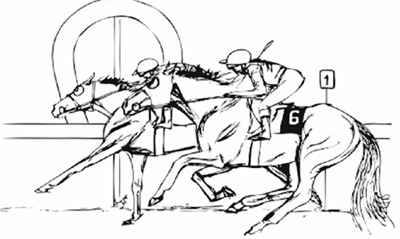
A note from Carolyn
I ‘d like to tell you about a special event that’s taking place at my ranch on Saturday October 4th.
If you own an ex-racehorse or are planning to purchase one… come and join horse racing hall-of-famer and Parelli student Julie Krone, race horse trainer Jack Frazier, ex amateur jockey Alessandra Deerinck DVM and myself for an open discussion about how we can all help racehorses make the transition from the racetrack to a second career.
You will also be able to see Alessandra work with her horse Rosalie, aka ex-racehorse Downtown Rosalie, and watch their progress towards bridleless riding and dressage using my Method.
This seminar will take place at:
Dances with Horses
2400 Summit Drive
Escondido CA 92025
on Saturday, October 4th
from 8 am to 11 am.
The fee is just $20.
We only have a limited number of spots and they will go fast, so please reserve your place now by calling Alessandra Deerinck on 760-735-8825 or e-mailing her at alessandrad@me.com
We look forward to seeing you there!
Carolyn Resnick |
|
| ~ September 8, 2008 ~ |
You want to go on vacation?
By Susie Tommaney |
Ha... as a fellow horse person I know it’s not that easy now is it. Often we do without vacations or weekend getaways because as caring, loving, animal owners, we feel that we are the only ones that can take care of them properly. This is a valid belief, however, there are qualified Horse/pet sitters available that do this as a daily profession ready and willing to earn your trust so you can reap the benefits of getting away. You might be pleasantly surprised that they can do a darned good job of it for you in your absence. Granted, as horse owners we must all agree it’s possible that another person will not clean the coral as well or the same way you do (maybe better), or pick out the stall as thoroughly (maybe worse), but are your animals safe, content and happy when you come home? Were you able to unwind, relax and enjoy yourself without worrying about your 4-legged family? Peace of mind and quality care is “Priceless” where our large and small animals are concerned.
The most important thing to consider when selecting a professional Horse/pet sitter is their credibility and knowledge of their occupation. Many pet sitters, teens and neighbors are confident they know just about everything there is to know about the average pet so they can throw food to horses and that’s good enough. This is not the correct attitude to take. Horses are not like dogs or cats. If their stomachs get gassy or they can’t digest and push through what they were fed they just can’t throw it up as with the domestic small animals. It takes a knowledgeable person to be able to read these signs of distress. Most non-horse owning people/ sitters will not recognize them or know that the average horse poops between 8-10 piles per day and the consistency can tell you a lot about the horses present condition.
As with any professional trade (plumber, electrician, auto mechanic, etc. etc. etc.) word of mouth marketing speaks volumes for the individual or company they represent and usually the good ones are worth all the effort to book appointments & waiting for. If you are going overnight or just the weekend and can ask your neighbor to throw food, that’s a blessing. If there is a responsible teen in the neighborhood that can help that’s great too. Something to consider if you choose to do this for short-term excursions is for you to educate that neighbor or teen by meeting a few times prior to your departure and be sure that your animals are comfortable with them and vice versa. Get them familiar with the individuals and handling if needed. Let them know the proper amounts of food & water and where it should be placed and refilled. Let them know where all the gates latch and the importance of closing all prior to leaving. Horses are extremely smart creatures with very nimble lips. If given the opportunity, they wiltry to unlock or undo just about anything that will let them out to visit other animals or into the feed room
What if you want to leave for a well deserved lengthy stay of 14 or more days? Would you feel comfortable asking your neighbor to do that much work on top of their everyday activities or the possible unreliable teenager who has an active social life ? I don’t think so. Neighborhood friendships could soon begin to deteriorate with that much goodwill expected, so this is where you need to research and plan for your Horse sitter well in advance of your vacation date. Try to contact your potential sitter at least one month in advance for your initial interview. By doing this you can personally interview them, review responsibilities, rates etc. and then introduce them to your animals for your animals to tell you what they think. Yes... you read it correctly. Watch your animals react to this person, read what they are saying with their body language back to this person. Animal people are pretty intuitive by nature so listen to what they have to say. Watch the expression in their eyes, their movement around this person and their attitude to see how comfortable they are with your animals. Animals will sense and respect whom they want around them. These signs are what is going to be able to make you feel comfortable with that person and allow you to consciously leave knowing you can trust them to do what is right by you and your animals or you need to interview another person. You will know when you have met the right person for your extended family.
Here are some suggestions when planning to leave for your vacation:
1) Critical , Notify your small and large animal Veterinarian that you will be out of town stating specific dates and someone (name individual) is caring for your animals. Leave on file in their office or with the sitter, a “prime directive” authorization should your animal become ill in your absence notifying them of the limit to which you are willing to spend and your wishes for the animal. Notify them you will accept all financial responsibility upon your return or leave a credit card number on file prior to departure.
2) Be sure to have enough food supplies on hand that should you for some unforeseen situation be delayed in your return, the animals can continue to be cared for in a proper manner.
3) Leave emergency contact information and an evacuation plan... Keys to truck and trailer, have them pre- hooked up if possible prior to leaving, and notify sitter if you have difficult loaders. If so... what are their options for walking the horse or horses out and to where. Make up dog tags for halters with horses name and owners phone number. Leave crates for smaller animals and leashes readily available should the need arise.
4) Notify all neighbors/relatives that they will be seeing an additional vehicle coming and going from you property and from what dates. Give description of the sitter’s vehicle and physical appearance. Ask local law enforcement to patrol when they can during your absence
5) For lengthy stays hold all mail and papers at the post office.
6) Put sprinklers and lights (inside and out) on timers or ask sitter to change daily. Notify sitter of any additional hand watering required. Try to rotate light timers for different rooms as though you were home.
7) Make sure that there is a back up key hidden somewhere, because even the best sitter can lock themself out with the keys inside (Been there done that)
8) Try to schedule all shoeing or Veterinarian maintenance requirements for your horses prior to leaving or upon your return. Notify your Horse sitter if other people/things will be coming and going from your property while you’re gone. Notify sitter if gates (Pool or gardeners) or trash dumpster need to be opened or pushed out and on what days.
9) Be clear and specific in your expectations for your animals care while you are gone. If you want your animals turned out, tell them for how long and if you expect them groomed after playtime. If you want them blanketed do you want them groomed first. If you want them hand walked when and where.
10) Foremost, find a person that will fit your personality and that of your animals. No amount of credentials is going to matter if you just don’t like the person or you don’t feel comfortable right off the bat. You have to sooth your sub-conscious in order to be able to have a relaxing time and by all means find one that makes themself available to you at any time to check up on how things are going at home.
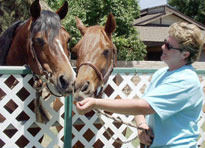
About the author:
Susie Tommaney is one of the industry founders for the specialized field of Horse sitting in Southern California, more specifically, in the East San Gabriel Valley and Inland Empire Valleys. She created Susie Q’s Horse Training and Equine Services in 1995 due to the need for quality vacation care of her own horses. “The most vital thing to remember is that the horse owner has to have a certain level of confidence in your ability to properly care for their animals” “At the time, I just didn’t feel there was much to choose from!"
With over 35 years experience herself and having done this specialized field of work for other people since she was a responsible neighborhood pre-teen, Susie started up Susie Q’s. As she developed a rapport with her clientele, new and established, clients started asking more of her by utilizing training skills and pulling from her knowledge and exposure to many equine disciplines and breeds.
For a more comprehensive listing of what to do for your “Absence Preperation Checklist” please feel free to review this printable form Susie developed as a time frame guideline prior to your leaving home. It can be found under “Vacation Care” on her website www.susieqshorsetraining.com |
|
| ~ August 29, 2008 ~ |
Does Your Performance Horse Have an Attitude Problem
or could the problem be an Ulcer brewing? |
When your normally well-behaved horse starts acting strangely, what do you do? Do you immediately think he's developing an attitude or do you look for other causes? If your horse demonstrates any or all of the behaviors below you may want to think twice before assuming he has an attitude problem:
● Refusing jumps
● Acting up
● Kicking in the trailer or stall
● Pinning his ears when you put your leg on
● Biting or kicking when his girth is tightened
While these may seem like a group of unrelated symptoms, they're not. They are common symptoms in horses with ulcers. Veterinarians and other researchers have recently recognized gastric and colonic ulcers as serious health threats, especially among performance horses or horses in training. The reasons ulcers are so common among these horses include:
● Infrequent high carbohydrate meals plus inadequate access to hay or pasture
● Heavy training schedules
● High stress environments
● Excessive use of drugs, especially non-steroidal and inflammatory drugs
Since most of the research has focused on gastric ulcers, we know quite a bit about the factors that cause them. One of the major causes is inadequate access to free choice hay or pasture. Horses are meant to eat continuously, so their stomachs secrete acid constantly. When they are able to graze constantly they secrete saliva, which has a buffering effect on the stomach acid.
Plus, the hay or grass forms a fibrous mat-like barrier between the acid in the lower portion of the stomach (where digestion is occurring) and the upper portion of the stomach, which cannot tolerate contact with the acid. The lower part of the stomach is protected by mucous while the upper part is not, so ulcers tend to form when acid moves into the upper portion of the stomach.
Exercise or a heavy training schedule is the second factor that can lead to gastric ulcers. When a horse exercises, he contracts his abdominal muscles, disrupting the protective fibrous mat and forcing acid into the upper portion of the stomach. Performance horses living in stalls may tense their abdominal muscles even when they are not exercising since regular barn activities may prevent them from fully relaxing, especially if they are not offered free choice hay to occupy their time. In contrast, horses living in pasture move about slowly in a relaxed manner.
A third cause of ulcers in performance horses is trailering. Horses must frequently tense their abdominal muscles to maintain balance in a moving trailer, which tends to have the same effect as heavy exercise. Since many people do not offer hay when hauling, their horses are faced with long, uncomfortable rides. It's no wonder that many horses start kicking and pawing in the trailer!
Finally, saddling and tightening the girth can cause your horse to tighten his muscles, forcing the acid into contact with any existing ulcers and aggravating ulcer pain. The association point for the stomach meridian lies under the back of the saddle where the ribs join the spine. If you suspect that your horse has ulcers, put light pressure on this point to see whether your horse has a pain response.
When a horse must be kept in training treating ulcers can be challenging. Most pharmaceutical products designed to treat ulcers act by blocking acid secretion. While this may be effective on a short term basis, it eventually interferes with proper digestion and adversely affects the health of the digestive system. Keeping your horse in as natural an environment as possible is best, including offering free choice hay, building digestive health, and providing nutritional support so the body can rapidly heal the ulcerated tissue. Horses can't use words to communicate with us so they have to send us signals when things aren't right. How many times do we confuse their attempts to communicate with a bad attitude? When a horse is punished for trying to communicate it causes him even more stress and discomfort, and the downward spiral continues. How many good horses have had their careers cut short because of discomfort from ulcers? Try supporting your horse's digestive tract and see how his performance and attitude improve. |
These are the facts:
● Stomach ulcers are common in horses.
● Approximately 91% of racehorses get stomach ulcers, regardless of age.
● Approximately 52% of other performance horses have ulcers.
● Approximately 57% of foals have stomach ulcers, particularly during the first several months of life.
● Approximately 50% of horses with ulcers show no outward signs of gastrointestinal disease.
● Stomach ulcers in horses are a major problem in adult horses as well as foals
How do I tell if my horses have stomach ulcers?
Most horses don't show any signs of ulcers and you'll end up turning them out because they don't perform on the track as their pedigree would have you expect them to.
What are the signs of ulcers
Poor appetite, colic, decreased performance, attitude change, poor body condition, weight loss, dullness of coat, intermittent nursing, intermittent colic, diarrhea, teeth grinding, excessive salivation, pot belly, rough hair coat. These can all be signs of gastric stomach ulcers. However the only certain way to diagnose is via endoscopy as these can be signs of other conditions. Always consult your veterinarian. Do you currently have a horse that
How are ulcers diagnosed?
Scope the horse with a 3-meter endoscope or treat each horse for three days and look for a change in appetite or temperament.
"If you see an improvement in them when treated you can be quite sure that they were suffering from the pain of stomach ulcers."
Dr Percy Sykes AM MRCVS MACVSc
Why do horses get ulcers?
Acid released in the stomach in the absence of feed is thought to be the main factor in the disease. The stress of training together with high energy feeds means for much of the day there is no eating. With no eating there is no chewing, so there is less saliva to neutralize the acid. As the acid splashes across the upper side of the stomach it eats away the lining to form, sometimes within days, deep bleeding ulcers. The pain leads to the list of clinical signs mentioned above.
Performance horses are more likely to develop stomach ulcers
Excessive acid can erode the protective lining and damage the stomach. The prevalence of ulcers in stabled horses results from many factors including the way the horses are fed and managed. The stress of training also may contribute to the formation of ulcers. It has been proposed that grains and pelleted concentrates can increase the production of gastrin (Gastrin is a major physiological regulator of gastric acid secretion. It also has an important trophic or growth-promoting influence on the gastric mucosa), a hormone that stimulates acid production and horses that are fed high grain diets are more likely to have higher gastric acidity.
What are the causes of gastric ulceration in all horses
Horses are grazing herbivores – they graze almost continually when left in pastured areas, and the small stomach (only 8-15 liters capacity) is ideally designed for small, regular meals, as will happen when horses graze for long periods. Horses are also designed to consume large volumes of forage (roughage), and to obtain the bulk of their energy intake from the breakdown of fiber and roughage into available energy, under normal circumstances. The real problem for horses arrives when they have their eating and chewing time restricted (by stabling horses and restricting feed times to one or two large meals daily), and then by further stressing digestive function by undergoing regular hard exercise (often on an empty stomach). So a normal grazing horse will chew and graze for up to 16-20 hours daily, almost constantly producing saliva to neutralize the stomach acid which is constantly being produced.
Normal meals high in fiber tend to absorb much of the stomach acid produced (remember that stomach acid is there to begin to digest and break down fibrous materials in the meal immediately after the food is chewed, broken up, and swallowed). Normal meals high in fiber also tend to stay in the stomach for longer periods than watery, or non-fibrous foods (including grains and mashes). The actual emptying time of the stomach is governed by the size of the meal – so a large meal will empty faster than a small meal. Similarly, a predominantly grain or concentrate meal will empty rapidly.
If the stomach empties quickly, there are long periods when acid is being produced, yet there is no food in the stomach, especially when horses have restricted feeding times because they are stabled and fed to a stable routine once or twice daily.
The most likely causes of gastric ulcers in horses include feeding management practices, physical stress, diet and specific medications given in high doses. Stomach ulcers in horses are a major problem in adult horses as well as foals. Despite the fact that there may not be obvious signs of stomach ulcers, they interfere with performance by affecting training, appetite, and temperament. Although stomach ulcers may heal when horses are turned out to pasture for an extended period of time, they usually don't heal without treatment while they continue in training.
The Equine Stomach – Why Do Horses get Ulcers?
In simple terms, equine gastric ulcers are caused because gastric acid (hydrochloric acid secreted by parts of the stomach lining), and, to a lesser degree, the digestive enzyme pepsin, irritate the lining of the stomach, causing ulceration.
EGUS – (Equine Gastric Ulcer Syndrome) is common in adult horses and foals.
With all of the information available to horse owners regarding gastric ulcers, it is worth taking a step back to establish what it is that actually causes gastric ulcers. The only way a horse owner can effectively prevent or treat gastric ulcers is when they have enough reliable information about what causes them in the first place. Given one time a day with feed or by syringe into the mouth Performance-Essentials Stomach Rebalance Ulcer Remedy might overcome obvious signs of ulcers within days but treatment for three weeks is required to heal ulcers. The background acid secretion in the stomach in the absence of feed is the main aggressive factor that causes ulcers. This treatment inhibits acid secretion from the glandular region of the stomach allowing ulcers to heal. The treatment is also useful to prevent ulcers but if treatment is discontinued ulcers are likely to flare-up. Fillies have had a reputation for being picky eaters. And it has been almost accepted that horses will fall away in condition the longer they stay in work. It is not surprising, therefore, that there has been a lot of myth surrounding training. Vets and trainers have had to battle with an insidious disease that has been hidden out of sight. |
For more information contact Cindy Ross
www.MinglewoodSolutions.com
Providing the Solutions for Health, Maintenance & Recovery
www.Performance-Essentials.com
Essential Solutions for Performance
www.EquiCurrent.com
A revolution in therapy
866-393-2805
503-523-8290 |
|
| ~ August 12, 2008 ~ |
"Keeping the The Show Horse Workout Fun and Varied"
by Sarah Allen |
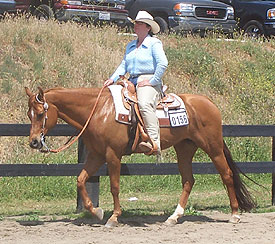 |
There are three ways I ride my show horses. I mix it up, following one of these three plans each of the 5 days a week I work a horse. Each way challenges a different part of their body and mind. It is important to develop a horse's whole personality. You want your horse to be able to handle and willing to try new and unexpected things. This ability to accept the world around him makes him safer and more enjoyable to be around.
The Hack: The perfect ride the the day or two after a horse show. I ride the horse around the property at the walk he offers me. If he wants to dilly dally or if he wants to truck it is fine with me. We wander down the driveway and walk down the street a bit. We come home and do an easy obstacle in the trail ring. We jog or lope a hill or two. We ride toward the barn and away from the barn over and over, being sure not to rush 'home' or refuse to go around the ranch again. After 30 minutes or so, we untack, shower and go to our stall. No tie out time.
The Drill: I take the horse straight to the arena. We lunge, if necessary. We walk, jog and lope circles for 20 minutes. I make sure the horse is responsive to my leg, moving over and forward when told. I make sure the horse's face is soft, giving to my hand readily. I check our stops, are they snappy and balanced? Then we work on the Hard Stuff. I go to what this horse has trouble performing. It does no good to ignore what isn't always fun to practice. It leaves a hole in your horse's training that will come back to haunt you in other ways until it is fixed. I make sure the horse is sound and comfortable. Have his hocks been injected if he needs it? Is his shoeing top notch? It is hard for the horse to be obedient when he is hurting. Does the horse understand what is expected of him? A confused horse cannot be obedient. If I am confident of his health and training thus far, I will create drills and exercises for him to practice a particular skill. I will r epeat and repeat until I can find the horse improving in some way. We quit on a good note and try again the next time. We untack, shower and stand tied.
The Trail Ride: The chance to try something new. We go to a real trail. A ride with water, traffic, hills, etc. I challenge the horse to be brave, willing and athletic. Choose trails that will push the horse a little but not shake his confidence. We come home, shower and go to our stall. No tie out time.

I hope the idea of riding with a specific plan will help you and your equine buddy.
I know it helps mine. |
|
| ~ August 1, 2008 ~ |
Horse Day-Care
Care for your horse when you cannot be there! |
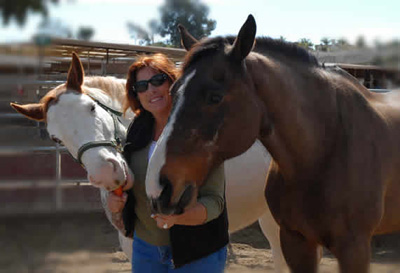 |
Have you ever been in a situation where you want to go on vacation, a business trip or just can’t get away from work during the day to take care of your horses needs, but you just cannot trust anyone to take care of your horse? Or how about an injury that requires more care than your schedule will allow? There is now an equine daycare provider that can help any horse owner with these daily tasks, from daily supplementing to injury care. Daycare services can help any horse owner with making sure your horse receives the quality care your horse deserves while you are away. These services prove to be very valuable to your horse’s regular routine care providing services when you just cannot be there to administer them yourself.
What you should expect from an equine daycare provider is someone who is prompt, reliable, follows your instructions to a “T”, is kind and caring to your animals, can identify when there is the onset of illness or lameness and has the knowledge to act according to the animals needs in a safe and responsible manner. A good caregiver will not hesitate to give you a call when it is necessary and will call the veterinarian in the time of need. They are knowledgeable, well educated, forward thinkers avoiding potential problems involving the safety and well being of your horse. Such as: feed changes, awareness of horses ability and present condition, handling & awareness of surroundings, understanding the horses temperament and individual needs.
Horse Lovers Haven Daycare, a licensed and insured full-care equine daycare service which is located at the Huntington Central Equestrian Center in Orange County, California. Inspiration came when Doreen Lettieri, a horse women with over 35 years experience, saw that there was a need for trustworthy all around daycare that even takes care of all the little things such as feeding supplements to major issues such as the care after an injury. Horse Lovers Haven Daycare also offers several services including hauling horses to and from clinics, horse shows, vet offices/hospitals, or trail rides. Being an a la carte style business, the services offered would fit into any budget. A daycare service, like Horse lovers Haven Daycare, takes away the worries of quality horse care in today’s society when we are constantly on the go. Horse Lover’s Haven Daycare can either take care of your horse at your location or can accommodate your needs at their location.

Take the worries out of horse ownership and a hectic schedule. To read more about Horse Lover’s Haven Daycare visit www.horselovershavendaycare.com. Emergency and after hours care always available. |
|
| ~ July 18, 2008 ~ |
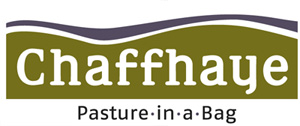 |
The Southern California Equestrian Directory would like to congratulate Chaffhaye – Pasture in a Bag for winning the bid on a Corporate Sponsorship advertising package within SoCalEquine.com. This Corporate Sponsorship advertising package was donated to the USET Foundation Olympic Benefit for the silent auction in conjunction with Dressage Festival of Champions on the road to Hong Kong to benefit the USET riders going to the 2008 Olympics in Hong Kong.
We would like to Welcome Chaffhaye – Pasture in a Bag to the directory and introduce our viewers to this fine product for horses. Here is some information you will find to be of interest if you own a horse or two or three or more ….
Recent USDA reports indicate a reduced hay supply for 2008. Combined with other economic factors, the trend of higher hay prices will continue. This is not good news to horse owners and stable managers already struggling to fine quality feed sources at affordable prices.
There is an alternative. Since 1991 Chaffhaye has been producing premium quality forages that are independently tested for consistent, nutritional content. ….. read more... |
|
| ~ July 2, 2008 ~ |
A Tribute to Kino “The Wonder Horse”
and his wonder-ful horse owner!
by Sue Schindler |
 |
It was a sunny, breezy day and Linda Hassakis was out to the ranch to see her 31 year old retired jumper, Kino. Carrots in hand, along with fly spray and some bandaging materials, she was out to dress a wound to the fetlock that Kino had gotten from a parasite. Kino was perky and upbeat, and loving the carrots as usual. As she tried to wrap the leg, Kino started to move in a circle, with his hindquarters pivoting around, trying to find a comfortable position to stand. As I drove up to the pasture to talk to Linda, I could see Kino moving about, making it difficult for Linda to complete the wrapping. |
| I went in with them, and together we were able to get Kino positioned to stand for the wrap, and then we both backed away. |
Kino still wanted to pivot in circles, with the front end staying kind of stationary and the back end going round. This is really weird, Linda and I both commented. “Do you think I should call out the vet?” she asked. “Yes,” I replied, “this is definitely not normal.” As we paged the attending vet, Dr. Linda Byer of All Equine Healthcare in Valley Center, Kino seemed to be getting more distressed and couldn’t gain control of his balance. I suggested Linda and I wait for the vet up at my house, telling myself I really don’t want Linda to see her horse fall.
As a young girl of 12 years old, Linda learned to ride in Los Angeles, taking Hunter-Jumper lessons at a barn near her house. She used to ride her scooter to the barn, muck stalls and ride horses. Then her parents bought Kino for her when she was fourteen. He was a huge, off the track, chestnut Thoroughbred. To this day, Linda would comment how she can’t believe her parents bought this “crazy” TB gelding for her! It’s a “wonder” she wasn’t thrown and hurt! Kino and Linda formed a special bond, going through years of training, jumping and competing all through Linda’s teenage and young adult years. Thus he became known as “The Wonder Horse!”
Linda and Kino’s partnership lasted through several barn relocations, due to changes in housing, jobs or barn closures. That is how we met – Linda had Kino at a barn in Del Mar which had been sold to developers. When she first came out to Showcase Quarter Horses to see the facility, it was October of 2000. She liked the private yet spacious paddock that would become Kino’s full retirement home …he was done being semi-retired and was now ready to live outside and just enjoy being a horse. I remember Linda said how important it was to her that this be the place where Kino can end his days; he had been moved around so much that she wanted him to live out life to his last days here. I told her I had started my ranch from nothing, had built it from the ground up with my father over the past four years, and I wasn’t going anywhere. She was at ease about the facility and moved Kino to Showcase on November 1, 2000.
For Kino’s care, Linda had specific requirements. He must be fed carrots every day and he was on daily bute, dewormer and we were instructed to mix pancake syrup over the bute to make it taste good. Just a spoonful of sugar makes the medicine go down, I thought to myself! Linda would be out every weekend to visit, to put fly spray on Kino, to spend time with him. Sometimes she would lunge him, other times she would give him a bath and grooming (no more mane pulling!). Kino really loved the shedding mitt, especially on his face. Linda also was adamant about keeping Kino well-shod even though he wasn’t being ridden. He was very over-at-the-knees and needed the support. For eight years she had Kino fully shod with pads, every six or seven weeks. Sometimes the shoes could be reset; in fact, there was one set of shoes that lasted about a year! Not really, but the farriers were good about utilizing the shoes and pads again whenever possible, as Kino wasn’t wearing them down much. This would always be done in Kino’s “Preferred Cross Tie” (sorry, a little inside joke from the barn!).
So time marches on and then came the 2003 Wildfires. All horses at our facility had to be evacuated, including Kino, and we weren’t sure if there would be a stables to come home to after the fires raged through Valley Center and Escondido. Fortunately, the fire came down our valley all around the stables, but only burned down the hay barn. The barns, mare motels, and houses were safe. The horses were off the premises for a hectic seven days. Kino was stabled in San Marcos and Linda went to see him several times to comfort him and make sure he wasn‘t too stressed. We had a lot of older retired horses to deal with at that time, and Kino weathered the firestorm evacuation like a trooper. I know all the horses were relieved when we trailered them home!
For a few more years, Linda and Kino were a regular retirement team, and after some vet checks we decided he needed to convert to eating soaked hay pellets and a senior equine complete feed. His condition bloomed and he really enjoyed eating on the veranda (the nickname for the nice covered area in Kino’s pasture). Linda also got a new sign for Kino’s pasture, made at the San Diego Fair. Of course, it reads: Kino, the Wonder Horse. Through the times we would write “Kino, The Wonder Horse” on his feed buckets, on his supplement containers, and even on his containers of bute!
On April 2, 2006, Kino celebrated his 30th birthday! What an amazing thing, to see this good old jumper still crazy after all these years!! Case in point, after a shoeing one day, Linda had to ask our facility Resident Trainer, Van Heggelund, to walk him back to the pasture as he was acting like a spring chicken (spring being the operative word-with a little rearing no less!). Linda invited a few of her close friends to visit Kino and mark the celebration. He also got a boat load of carrots that day!
In 2007, we were victims of the next wildfire, had to evacuate again, and Kino had to be kept in a barn stall. He did alright but after returning home (there was no damage to the stables this time) Linda noticed a change in Kino’s demeanor. Looking back, she really hadn’t thought much of it at the time, but these life stresses can take their toll. April, 2008 came around, and Kino celebrated his 31st birthday! One great thing Linda always did with Kino was take a birthday picture to remember how he was at a certain age. This year, Linda took the birthday picture with Kino and her new puppy, Rocco.

Kino didn’t really mind the young pup much, as long as the carrots kept flowing. In fact, Rocco would get jealous because Linda would tie him up at the fence outside the pasture, then spend her time with Kino. Kino was spending most of his time in the pasture, so Linda and her vet Dr. Byer had determined it was time to remove Kino’s shoes. This decision had been a big one for Linda for years-to shoe or to pull the shoes…..she didn’t want Kino to be so sore that he couldn’t walk if the shoes were pulled. The deciding factor came with his most recent shoeing appointment, where farrier Jeremy Sackett pointed out that Kino was really off balance and having trouble stabilizing. Linda didn’t want Kino to have a traumatic time during shoeing, with the threat of losing his balance and falling, so she consulted with Dr. Byer, who advised Linda to remove the shoes and just trim his hooves. Jeremy came out for the next appointment, went to Kino’s pasture so he wouldn’t have to walk so far to the other side of the ranch where the barns are, and took off the shoes. We buted Kino for the next several days, anticipating some pain. He seemed to be doing pretty good, and we reduced the amount of bute. Then came the fetlock sore, with Linda doctoring it every few days.
Fast forward to waiting for Dr. Byer, the vet, to arrive at Showcase. Linda and I went out to the pasture when the vet got there. Kino was already down. We described the pivoting actions Kino had taken, and Dr. Byer said it was time to put him down. She said this kind of thing happens in very old horses, usually over 20 years in age, and it just comes on swiftly. Linda was worried that the stress of removing the shoes, coupled with the injured fetlock had somehow caused this downturn. The vet assured her that it would have happened whether Kino was wearing shoes or not; it was just his time. Linda tearfully said her last goodbye and gave Kino a kiss on his neck. He was at peace now, and I told Linda that I hoped the other ponies in horse-heaven would teach Kino how to graze (he never learned to munch on the grass in his pasture). She remarked that she knew his soul was happy, and that she was grateful she was able to be there to comfort him at the end of his life.
This true story is a tribute to Kino, The Wonder Horse, but also to Linda, who I now think of as The Wonder Horse Owner. It simply boils down to character and a love of her horse; Linda took the best care of Kino in his senior years just as he had taken his best care of her as his rider and owner in his primetime. To continue to provide whatever Kino needed, for twenty four years, and give him the love and attention she did is a testament to the integrity of this Wonderful Horse Owner. My wish in honor of Kino is for all horses to experience this unconditional commitment from some Wonder-ful horse owner in their lives…
Written in rememberance of Kino and for his owner, Linda Hassakis
by Sue Schindler, Owner/Operator of Showcase Quarter Horses |
|
| ~ June 24, 2008 ~ |
Backcountry Horsemen of California
trains riders in wilderness use
Sherli Leonard |
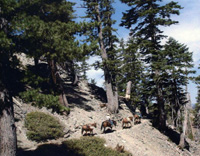 |
It’s dirty, it’s hard work, and it can be dangerous. Packing into the backcountry with livestock can challenge the most rugged equestrians, but one quiet ride on a single-track trail through a high mountain meadow with a good horse, a solid pack mule, and good companions could convert most folks into backcountry horsemen. |
Imagine riding four or five hours in spectacular country, finding an isolated meadow, off-loading your pack animal in the tree-covered hillside nearby and setting up a small camp. You hobble your stock out to graze, then set up a propane stove to brew some strong cowboy coffee. (Of course, “strong cowboy coffee” is redundant.) Settle back against a rock and listen to the hawks guiding their young, the trees shifting in the afternoon breeze, the soft munching of the horse, and nothing else. These are the perks of the dirt, the hard work, and the danger.
Now imagine riding into that meadow and you find bare spots where the stock have overgrazed, holes around the trees where the horses have pawed the ground, several blackened fire pits, and bits of toilet paper floating around. That’s a different scene, and that’s what the Wilderness Riders of the Backcountry Horsemen of California (BCHC) want to prevent.
“We want people to use the backcountry, but not abuse it,” said Wilderness Rider Jo Johnson, education chair for the San Joaquin Sierra Unit of the BCHC.
Using the backcountry, whether on horseback, on bicycle tires, or on foot, carries a responsibility to be gentle with the land, to leave no trace behind, and to be considerate of the horse and the other users. According to the Wilderness Riders, the essence of responsible and enjoyable backcountry use is leaving it in a condition that you would like to find it. This means riders plan ahead, come prepared, and use courtesy and care.
“You have to know where you’re going and what kind of camping you will have,” said Johnson. “You need to be prepared for emergencies for riders and stock, know the right places to set up camp, pack out any waste you create, store your supplies so bears and other wildlife can’t get them, and stay on the trail.”
According to the BCHC Web site, a major consideration for backcountry stock users involves gentle stock management. Horses simply can’t go from a meal of alfalfa hay one night to grass or pellets the next. They need to be conditioned in advance of the trip to prevent colic episodes many miles from any help.
Riders need to practice with their horse before they go into the backcountry so the horse knows about highlines, hobbles, pickets, electric fences or loose grazing. They also need to be accustomed to crossing noisy wooden bridges, logs, rocky trails, and dark and spooky water crossings. The first hour of a five-day pack trip is not the time to be training a horse to calmly climb a steep, rocky trail in a single-file line of stock.
According to Johnson, there are 47 active certified Wilderness Riders in California, and each one has been through a rigorous week-long practical training process. The course is usually taught by a representative of the United States Forest Service, a representative from the State Park Service, and two Leave No Trace Stock Users Masters. The training is designed to teach Gentle Use and Leave No Trace techniques to qualified BCHC members who then are charged to go back to their individual units and teach the principles to more people.
“As a Wilderness Rider, you really should have a love of teaching,” said Johnson. “The main thrust of the program is to spread the word about Low Impact Camping and Packing techniques. It’s the most incredible thing I had done in a long time.”
BCHC San Diego Unit President Cheryl Wegner agrees.
“I went in the summer of 2007,” said Wegner. “It was a great life experience for my horse and me. We each were given one Leave No Trace component to teach, and we had to come prepared with all our materials. It’s a fabulous program. I was honored to be selected and excited to learn from the dedicated experienced instructors on our trip.”
BCHC has about 3,200 members in 26 units throughout the state of California, from Yreka to San Diego, the bay area to Bishop. Formed in 1986 to preserve the historic use of trails for recreational pack and saddle stock, the group works through education and public outreach programs, activities and events, public service, and advocacy to encourage safe and enjoyable wilderness and backcountry experiences for all users.
For those dedicated equestrians who can’t get enough of the backcountry-horse combination, the Wilderness Riders program is just the ticket.
“It’s an absolutely fun thing to do,” said Lynn Joiner, BCHC treasurer and long-time Wilderness Rider.
Wilderness Rider candidates apply for training every odd-numbered year. The process involves a written application and an interview to determine the candidate’s level of commitment and capability to perform the required tasks. Once accepted, candidates prepare their instruction assignment and gather at the designated training center, a different place each year. In 2007, the training involved ten students, two cooks, and three instructors including Forest Service Region 5 LNT coordinator Ken Graves, and took place in the Shasta-Trinity National Forest.
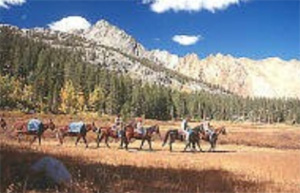
They spend one day learning and practicing packing techniques before heading out into the wilderness. After a four or five-hour ride to the base camp site, they work together to set up camp including cleaning the restrooms, setting up a kitchen and putting up the highlines and tents.
For the next five days, candidates learn how to weigh a load, saddle a pack animal, throw a box hitch, manage livestock in the backcountry, minimize campfire impact, pack and prepare food, all the while respecting the environment and the wildlife.
Once certified as a Wilderness Rider, the trainees have their own responsibilities. They are required to serve two stints in the backcountry each year, patrolling for problems at campsites and generally helping all backcountry users have a more enjoyable experience.
At the Golden Trout Wilderness in 2007, Joiner contacted lots of hikers and riders.
“We carried backpacks for them, fed the backpackers, found the lost, and generally helped wherever we were needed,” she said.
They also have to make at least one Gentle Use and Leave No Trace presentation each year. For Wegner, being able to go back to her unit to conduct education and outreach was a main reason for taking the training.
Current Wilderness Riders meet every even-numbered year to review their training and Gentle Use techniques.
Candidates for the 2009 training will be interviewed at the 2009 Rendezvous, the BCHC’s annual three-day expo usually held in March in Turlock, California. The BCHC Education Committee will conduct the interviews and do the screening.
“We’re looking for candidates who have the capacity to carry out the training and fulfill their obligations,” said Joiner. “We don’t consider ourselves elite, unless you consider cleaning up a dirty camp or helping a sick backpacker a special activity.”
For complete information about the BCHC Wilderness Rider program, visit www.bchcalifornia.net. |
 |
|
| ~ June 10, 2008 ~ |
Ollie's Story
By Deborah Norwood |
| We got Ollie in June of last year. At the time he didn't look too bad...we were buying him for next to nothing ($500, WITH a saddle, that we ended up giving to a friend) from a woman who had pretty much rescued him from a home where he was just out in a pasture with several other horses, given water and eating the naturally growing grasses, but not much else in the way of health care. I was told that when Cheri first bought him and brought him home, she told her friends not to laugh...because he was so shaggy he resembled a long-haired billy goat. His hooves were so grown out he was nearly lame. She shaved him, had the farrier work on him, and thought he'd be a good pony for her daughter. But after a couple months her daughter had really lost interest...so she was trying to find a home for him. That's when we came into the picture. |
We took him on knowing he might have Cushing's...and we only knew that because another person at the place he was being boarded told me to 'be careful' because she'd seen him when he first came in...and his long hair was a sign that he might have Cushing's. Knowing NOTHING (at the time...now I can tell you ALL about it), I looked it up online and saw that it was a treatable disease. My 9 year old daughter had been taking riding lessons off and on for about 3 years at that point, but her confidence was low after a series of falls. Since she only rode when she was having a lesson, she wasn't getting much practice. Ollie was very gentle and very well trained. So we decided to take him on.
This is what he looked like when we first got him (6-07):
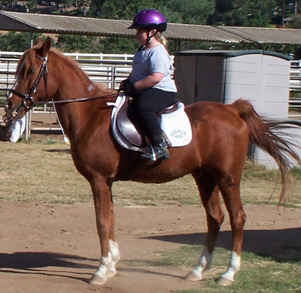
He's been freshly shaved and he looked pretty good. He was WONDERFUL with Monica...and we thought we'd made a very good deal. Shortly after we bought him, Hawthorne closed down their boarding facilities, so we moved him to San Pasqual Valley Ranch, with some friends of ours who also ride and have 2 horses. At that time, we were told about a great vet, Dr. Matt Matthews, so we called him to give Ollie a once-over, and to talk about the possibility of him having Cushing's. He said there are a few other things that can also cause the long hair growth...which is caused by the natural cortisone level being too high in the horse...something that naturally happens during winter to help the horse grow a 'winter coat'. His first recommendation was a diet change. He'd been on Bermuda hay when we bought him from Cheri. We'd changed him to Orchard (because a friend recommended it), and I'd also added Gleam and Gain, just to help him put on some weight (he was thin). The vet recommended adding some good vitamins to that (which we did), and said, with the pellets they feed at SPVR added in, too, he would probably do well. He seemed to be doing much better...until the fires hit in October.
Then he completely crashed. This what he looked like when he came home from the Del Mar Fairgrounds:

The stress of the fires threw his Cushing's into a full-blown crisis. When the vet tested his blood, his thyroid levels were so low they didn't even register in the blood. His blood was thick with fat, which had backed up from his liver, which was shutting down. Basically, Cushing's is a disease that causes the pituary and adrenal glands to not work correctly. That in turn caused the thyroid to stop working, which caused him to be in liver failure. The fatty blood caused him to be high risk for a stroke, so Dr. Matt Matthews DVM gave him daily liquid aspirin shots for a while. When he developed a bloody nose, he cut back on the dosage, but continued to come out daily to test his blood and check on him. After much work on his part, a lot of work on our part, and some fabulous medications (Pergolide, a neurotransmitter medication that was first created for human Parkinson patients, but was pulled after it was shown to cause heart problems in adults, then re-released for equine use after the Veterinary Medical board pushed for it's use in horses...it is a miracle drug, in my opinion), and thyroid medication, Ollie now has the chance to live a fairly normal life. He'll be on these medications the rest of his life, but that's fine with us...as long as it keeps him healthy.
One other point you should know...Dr. Matt didn't charge us one red cent for all his work. He billed it all through an Equine Recovery Fund that he runs, and as far as we're concerned, he just about 'walks on water'.
This is how he looked after he'd recovered enough to be ridden a little (still with the long, curly coat caused by Cushing's...sadly, some people called him the "wooly beast" at the ranch):
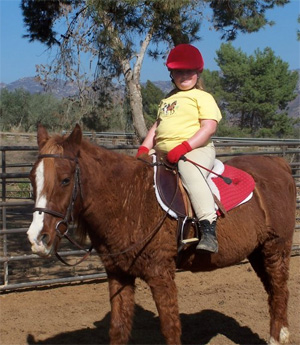
This is how he looks now (May 08):
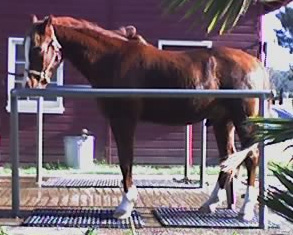
6-1-08 Monica wins two 4th place ribbons at the Vista Palomar Riders horse show (doesn't Ollie look PROUD?):

SO...I hope you've enjoyed hearing Ollie's story. He's sure come a long way and we are so proud of him. We love him more than words can say. :)
Hugs, Debby |
|
| ~ May 20, 2008 ~ |
| The San Diego Interscholastic Equestrian League |
| SDIEL |
 |
There’s an exciting new opportunity forming in San Diego for junior high and high school equestrians called The San Diego Interscholastic Equestrian League (SDIEL).
Forming the SDIEL developed from the awareness that we could provide our children with an extra dimension in riding… the ability to represent their school with what they love to do best… ride. We are very excited to give our children the opportunity to be a part of a “high school team” and to promote the awareness of this sport at the high school level.
The primary goals of the SDIEL are: to embrace fair and friendly high school competition and high school team spirit; to encourage a knowledge of horsemanship and the development of superior riding skills in young riders; and to support and develop athletes for regional and national competition in equestrian sports.
Who to Contact for More Information?
An Organizing Committee dedicated to supporting the creation of the SDIEL has been established. Until our SDIEL website is up and running, the individuals listed below are those to contact if you have further questions:
Hunter/Jumper Division Representatives:
Shayne Berridge-Wireman, President, GSDHJA, contact via email at chestnuthillec@aol.com
James Waldman, Vice President, GSDHJA, contact via email at jwqhf@sbcglobal.net
Parent Representatives:
Debi Gibney, contact via email at debigibney@aol.com
Manou Allison, contact via email at akemo5@aol.com
SDIEL Overview
Creation
The San Diego Interscholastic League (SDIEL) is being created in the image of both the Los Angeles Interscholastic League (IEL), and the Orange County Interscholastic Equestrian League (OCIEL), two organizations that have many years of competition behind them; we are not starting from scratch. We invite you to explore their websites at www.ociel.org and www.theiel.org. Please keep in mind that modifications will be made to their rules and regulations, however the premise and format will be largely the same. A website for the SDIEL will be established and is forthcoming.
Membership
Any school interested in participating in the activities of the SDIEL and willing to subscribe to the bylaws and rules of the SDIEL is eligible for membership. A SDIEL High School Membership Form will be required, and will be properly signed by an official of the school empowered to do so. Said form shall also identify the Team Representative and/or Coach.
Fees
Specific fees are yet to be determined, however, the fee structure will be similar to the regular fees incurred at a county level show.
Show Format/Divisions
The show season will fall somewhere between October and March (dependent upon facility availability), and will consist of six one-day shows over a total of three weekends. The SDIEL will offer classes in Hunter/Jumper, Dressage and Western riding at the Novice, Freshman, Junior Varsity and Varsity levels. The SDIEL class list is as follows:
Hunter Novice
A beginning division, open to riders who have not shown successfully in any recognized show association (ie. OCIEL, IEL, PCHA, OCHSA, GSDHJA). Fences will be set at 2’-3”.
Hunter/Jumper Freshman
Open to riders who have not shown successfully over a 3’-0” course at any recognized show association (ie. OCIEL, IEL, PCHA, OCHSA, GSDHJA). Fences will be set at 2’-6”, and medal and jumper classes to be set at 2’-6” to 2’-9”.
Hunter/Jumper Junior Varsity
Open to riders who have not shown successfully over a 3’-6” course at any recognized show association (ie. OCIEL, IEL, PCHA, OCHSA, GSDHJA). Fences will be set at 3’-0”, and medal and jumper classes to be set at 3’-0” to 3’-3”.
Hunter/Jumper Varsity
Fences will be set at 3’-3”, and medal and jumper classes to be set at 3’-3” to 3’-6”.
Western Novice, Western Freshman, Western Junior Varsity and Western Varsity
Open to riders… (to be determined).
Dressage Novice, Dressage Freshman, Dressage Junior Varsity and Dressage Varsity
Open to riders… (tbd).
Ribbons/Points/Trophies
Ribbons will be awarded to 1st through 12th places, and prizes will be awarded to the 1st place winner in each class. Individual points shall be awarded for all classes and counted for all riders. High Point and High Point Reserve Individual and School ribbons will be awarded at each show in each division, and overall for each show. The best 4 of 6 show points will be counted for individual, division and school. No rider shall be considered for year-end awards unless they attend a minimum of 3 shows. Year end/perpetual trophies will be awarded at the end of the show season. Each division will have a high-point school and individual winner.
The SDIEL Horsemanship Award will be awarded on a yearly basis. It will consist of a written section and a practicum (with horse) that will test the student on general knowledge of horse, tack, and animal care. The highest scoring individual in each of the English/Dressage (combined for this award) and Western divisions will be awarded a perpetual trophy for their achievements.
Senior Scholarships
It is the goal of the SDIEL to offer scholarships to high school seniors on an annual basis. The criteria for awarding senior scholarships are yet to be determined.
Sponsorship Opportunities
At this point, the SDIEL is a non-profit corporation awaiting approval from the IRS for charitable status. The success of the SDIEL will be dependent upon the generosity of our supporters. Opportunities for sponsorship for businesses/families will be made available as early as possible.
Looking Forward to Riding at the College Level?
There are two ways to participate in riding at the college level: the Interscholastic Horse Show Association (IHSA) and the National Collegiate Athletic Association (NCAA). |
NEED MORE INFORMATION?
WE ARE ASKING PARENTS/RIDERS TO CONTACT
our parent representatives:
Debi Gibney via email at debigibney@aol.com or
Manou Allison via email at akemo5@aol.com
Organizing Committee members: Shayne Wireman & James Waldman |
|
| ~ April 30, 2008 ~ |
State Park Closures
A Threat we can't allow |
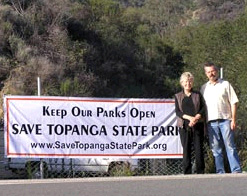 |
The Facts
As We Know Them
Cutting The Budget
At California State Parks And
Closing Any Park or Beach Is Plain Wrong |
Just a 3 mile drive from Santa Monica, Topanga State Park is 2.5 times larger than that city. It was visited 470,000 times last year, and the Governor thinks it should be closed!
Schwarzenegger's Proposal
To close a projected California state budget deficit of $16 billion, Governor Schwarzenegger has proposed a 10% across-the-board reduction for state agencies. The total budget amount - $101 billion. If this passes, 7000 state employees will lose their jobs in the next 18 months.
State Parks has been forced to draw up plans to close 48 parks and cut seasonal employee hours in half. Although savings of $17 million is expected, closures will cause a loss of income of almost $4 million. Last year the public visited the parks listed for closure 6.5 million times.
Three parks close to us are on the closure list - Los Encinos State Historic Park (located at Balboa and Ventura in Encino), Topanga State Park (in the Santa Monica Mountains) and Will Rogers State Historic Park (entrance via Sunset).
We are still a bit stunned and wholly outraged. The state park system is to be decimated over just $14 million! We're not here to say where the money should come from, just that it should be found. California CAN afford it's entire State Park system.
Assembly Bill 2392, which would have started the process to sell the closed parks has been completely changed to serve the legitimate conservation purpose of protecting the California Condor, our enormous and threatened vulture. So ONE threat to our parks is gone, for now. But this experience showed us where the tax-cut folks and their big money allies, the developers, are headed. And what can happen if we don't speak up - we could lose Topanga to subdivision.
Schwarzenegger has an enormous budget problem. We can take this seriously or we can waste time -
- guessing about the Governor's real motives,
- believing that he can't really be serious,
- waiting for the Legislature to do the right thing,
- ignoring the permanent damage that can be done to State Parks,
- imagining how we personally will get into the park anyway,
- ignoring the risks of injuries and fires in an unprotected park?
Or, are we going to defend our parks? Let's take action to
- protect our own beautiful Topanga State Park,
- make common cause with our neighbors at Los Encinos & Will Rogers State Historic Parks
- join the statewide Save Our State Parks campaign
- protect the natural and historic conservation purpose of all state parks,
- protect the long-term financial viability of the state park system.
What's At Stake?
- CLOSED: 50 mi. of trails for hikers, mountain bikers, runners & equestrians
- CLOSED: 18 miles of the famed Backbone Trail
- CLOSED: Unique outdoor classroom for 1000s of schoolchildren
- LOST: 700,000 visitor trips past businesses near Topanga/Will Rogers
- RISKED: Damage from unsupervised visitors
- RISKED: Sale of parklands (legislation recently introduced)
- RISKED: Long term survival of State Park system
Frugality At California State Parks
California State Parks has a 25 year history of staff and funding cuts in response to state budget crisis.
A first response, begun during the fiscal crisis of the 1980s, was to temporarily put off maintenance to roofs, bathrooms, roads, fences and trails. What was supposed to be a temporary delay has become permanent. The department estimates the cost to complete deferred repairs at about $1 billion. Periodically the legislature addresses the backlog as it did with a one time $250 million appropriation in 2006/2007. It seems like a lot of money unless you understand that the backlog will increase about $117 million this year.
During a budget crisis in the 1990s, California State Parks cut 572 positions and 30% of managers and supervisors. Over the last five years General Fund revenue has been reduced by $65 million and only partially replaced with fees and transfers. The net result has been a $10.5 million loss of revenue to the department during that time. In 2003/2004 California State Parks eliminated 90 more positions and moved field staff out of leased buildings into modular units on State property.
The proposed cut for 2008/2009 is $13.3 million out of a total budget of $149 million. Staff will be cut by 136 permanent positions and 100,000 seasonal hours will be eliminated. The department has been authorized to have 2,467 permanent staff and approximately 2,700 seasonal staff.
To give a sense of the scale of these cuts, California State Parks estimates that in 1990-91 they spent $4.16 per park visit. The 2008/2009 budget proposal will bring that down to $2.80 per visit in inflation-adjusted 2006-07 dollars. People may talk loosely about "waste and fat in government," but they'd be wrong to talk that way about California State Parks.
Closing Topanga State Park Hurts Real People
According to the California State Park System Statistical Report, our park gets almost half a million visits a year. Only 13 of the 134 California State Parks and State Historic Parks get more visitors. Why does the Governor want to close such a popular park? You know some of the tens of thousands of people who’ll be hurt: children on field trips and scouting expeditions, joggers, hikers, picnickers, equestrians, mountain bikers, families, neighbors: in other words you and me. We’re the people who worked hard to get this park in the first place!
Can 13,000 Acres Of Wilderness Park In Los Angeles Really Be Closed?
Our park’s 30 mile boundary is unfenced. Only the parking lots have gates. It’s accessible from the Backbone Trail, the unpaved portion of Mulholland, and hundreds of back-yards. People can’t really be kept out with fewer staff. What are the risks from unsupervised visitors? Is it fire-safe? What will be lost when maintenance is cut back? How can this actually save money?
Topanga is so beautiful this spring.
Here's a link to an excellent show of photographs taken at Topanga State Park by photographer Gary Valle (who joins us in opposition to any State Park closures). Thanks to Gary for showing why we love this place.
It's not just Topanga State Park!
Five Parks to be Closed in LA County & Four Beaches in Orange County.
The five parks: Topanga State Park in the Santa Monica Mountains (12,666 acres of wilderness); Will Rogers State Historic Park in Pacific Palisades (189 acres & Rogers history); Los Encinos State Historic Park in Encino (living history); Pio Pico State Historic Park in Whittier (school tours); Santa Susana Pass State Historic Park in Chatsworth (671 acres of wilderness). The beaches are Bolsa Chica, Doheny, Huntington, and San Clemente. San Onofre State Beach, actually located in San Diego County, is also listed for closure. Here's a list of all 64 beach and park closures by County.
None of these parks should be closed!
Who are we?
We're a group of private citizens and Topanga Canyon Docents asking California's Governor and Legislature to keep Topanga State Park, Will Rogers State Historic Park and all California's State Parks and Beaches OPEN. |
http://www.savetopangastatepark.org/
info@SaveTopangaStatePark.org |
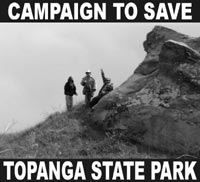 |
|
| ~ April 24, 2008 ~ |
Trail Trials
by Sherli Leonard |
 |
Horses and trails go together like a good car on a good road, and the Redshank Riders of the Backcountry Horsemen of California want to help riders and horses make the most of their time on the trail. The Third Annual Trail Trial on Saturday, May 17 will challenge riders and horses in an event designed to test their skills on the trail.
“This is one of only a few qualifying events held in Southern California for the State Finals in Trail Trials,” said Stacy Kuhns, Redshank Riders president. “It is sanctioned by the California State Horsemen’s Association and will be judged by a Senior Judge.”
The closely monitored competition will include a minimum of 10 obstacles over a real trail course which will take approximately two hours to complete. While the obstacles will be typical of what a horse and rider might actually encounter on the trail, Kuhns declined to describe the obstacles for this event.
“We keep that information secret, but competitors can find out the possible obstacles by going to www.trailtrials.com,” said Kuhns.
A much more practical application of trail riding skills than a typical Trail Horse class at a horse show, the trail trials competition emphasizes a rider’s understanding of Leave No Trace trail riding techniques. Complete information about Leave No Trace and Gentle Use techniques is available at www.bchcalifornia.net, and more information will be available at the event.
In the competition, riders must carry a hoof pick, knife, supply of water, halter and lead rope, and a pair of pliers or leather-man tool. Carrying a first aid kit will earn extra points. Riders may use any style of saddle and bridle or hackamore. They may wear any type of clothing suitable to riding, and must wear appropriate riding footwear with heels. Helmets are required for all juniors and recommended for all riders.
No stallions are permitted and no dogs are allowed at the event. Also, alcohol use and smoking are absolutely prohibited while on the trail trial course.
According to Kuhns, riders may participate even though they do not compete.
“Some riders are just getting into this, so aren’t ready to compete,” Kuhns said. “They can participate for a schooling fee of $20 and ride the same course as the competitors. It’s really awesome experience.”
Riders can also just ride along to accompany competing horses and riders without negotiating the obstacles. This companion horse category costs $20.
The entry fee is $45 per competing horse, and prizes will be awarded in each category: Advanced, Intermediate, or Novice in three age categories, 17 and under, 18 to 49, and 50 and over. Entries are limited to the first 75 registrants. A $5.00 discount will apply to all registrations postmarked by May 5.
Entry is opened to all riders, whether or not a Backcountry Horsemen of California member. BCHC memberships will be available at the event.
The local 4-H group will be the food vendors for the event, earning money to send their members to state competitions.
Little Creek Ranch is located on Hwy 371 in Anza. Watch for BCHC signs.
To register, contact Paulette Johnson, 951-767-7099 or go to cricandthree@aol.com. For more information, contact Stacy Kuhns, 909-633-1705 or go to stacykuhns@aol.com. |
|
| ~ April 18, 2008 ~ |
Could I benefit from lessons?
by Susie Tommaney |
 |
How did we all learn to ride? Countless numbers of us do it and own our own horses so let’s take a moment to reflect and ask ourselves. Was it a ride on the Merry go round strapped to the pole, a coin operated galloping horse in front of the grocery store or when you were a kid did you go to summer camp and absolutely fall in love the with “‘best pony named Freckles! ”Oh Mom, Dad can we buy her please”“ I promise to take out the trash, clean up my room and do my homework please pretty please?” Sound familiar? |
| Probably the hardest thing you ever did was to groom Freckles one last time & say your good by’s to ”Freckles” only to dream about her for weeks on end as you drifted off to sleep. |
|
How did you learn to ride? Are your skills built on a solid foundation of correct posture and seat? Building blocks that have been with you for years since your childhood summer camp or did you just wing it and say forget the lessons I can do this just fine by myself, hopped on, and went! Everyone... can benefit from lessons.
Today’s horseback riding techniques and skills have greatly improved. There is a visible difference between a “True horseman/woman” and just someone that rides. Today’s horsemen and woman have learned to embellish the fundamentals of classical Dressage and incorporate them into just about every riding discipline there is within the equine community.
There are so many things “You” can do to help your horse’s balance and drive from the rear by learning how to properly ride your horse’s gaits. Posture, proper hand and leg contact and lightness will make every ride more comfortable and enjoyable for both you and your horse. Have you ever thought to ask someone riding behind you, am I sitting up straight? Heavier to the left or right? Is it my hip? shoulder?, or am I collapsed in the rib cage! Do you know enough about your self- carriage while riding to pinpoint which of theses areas have issues? More than likely you are unaware of these common riding faults within yourself unless a more educated person is overseeing your riding.
Why should I spend the money and take riding lessons? I haven’t fallen off yet and don’t intend to! One can certainly entertain that train of thought and logic, however, why not invest in yourself and your horse. Let advancement and enhancement of your existing skills carry you to the next level. Wouldn’t it be nice to communicate with “Old Dobber” in such a manner that he is so willing to do what you want he gladly does it and quickly! Do you think your horse has a rent string mentality and doesn’t listen to your commands? Well then, it sounds to me like you could benefit from some lessons. Here are some simple guidelines to follow:
What to look for in a riding instructor? First and foremost, someone that practices and preaches SAFETY AROUND HORSES! You are dealing with 800-1200 lbs sometimes more, of raw power so you better learn how to posture yourself for safety around that. Does that person have to be a “certified instructor” by an accredited school or program to be a good instructor? Not necessarily. Word of mouth reputation speaks volumes because those people that can readily recommend someone are already satisfied customers. Watch and ask people with riding skills and techniques you admire where they learned what they know and see if it is a local instructor. Set up a meeting with that individual and ask for references from them. Most instructors will gladly give you names of satisfied customers they are either currently helping or have helped. Find out what the instructor’s accomplishments and disciplines are and how long they have been instructing. Does that instructor need to have World Champion accolades to be a good instructor? Not necessarily. After meeting this instructor what is your gut feeling about your meeting.
What constitutes a “Good” Riding Instructor? Someone that has the ability to clearly and concisely explain to you, a specific point, process, or technique, in such a manner that it easily shows how that point, process, or technique should be applied effectively, & how it benefits you and your horse as the end result! This instructor should have the ability to watch the horse you are riding, read their body language and notify you when to accurately apply and execute a specific technique to either eliminate a bad situation (buck or spin) or enhance the horses performance. With horses, getting what you want is all about good timing on the rider’s behalf. Any riding instructor you choose should have the patience, patience, patience, to work with both horse and rider as each learns at different levels for different applications A forthright instructor will educate you and your horse to the best of their ability and be honest enough to tell you when you have gone as far as they can help and when it’s time to move on..
Secondly, you need to be able to identify your problem areas. What it is that you would like to learn for yourself, or learn how to teach your horse. Not everyone or horse learns at the same speed and your instructor must be flexible enough to find a comfort zone at which you can learn new skills and have patience with the horse you own. If you are happy with your horse and he is suited to you for what you want to do with him (show, pleasure, trail) then don’t be pressured into buying a horse that your riding instructor has because he is “trained”. Your horse is not disposable like tissue after you blow your nose! Give him or her a chance. You chose him for a reason so stick with it unless it becomes too dangerous! Any good instructor should be able to develop a foundation of building blocks for you & your horse that challenges you to continually grow & succeed. They should be able to help you pinpoint a starting, mid-point, and graduation from that goal. Foremost, remember that your horse could be learning new things as well so expect that you will both have ups and downs but the end result will benefit both from taking lessons and just have fun with it!
|
Biography:
Susie Tommaney is a freelance writer who established her own Mobile Horse Training, Lesson and Vacation care business Susie Q’s Horse Training and Equine Services 13 years ago at the request of some of her clients. Susie’s forte is bringing horse and rider together as a team. Whether they show, ride pleasure or trail, Susie’s clients can attest that she loves what she does and their horses love her too! Look for future articles seen here by Susie on “Preparation for your vacation care” and more. With over 40 years of horse experience you can bet she has a lot up her sleeve and she is willing to share with the beginner to the advanced! |
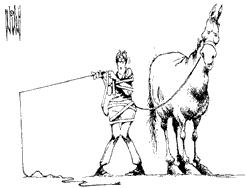
Don't let this happen to you!
Call Susie Q's! |
| Visit her website www.susieqshorsetraining.com for more information. |
|
| ~ April 7, 2008 ~ |
| WSHE Mustang Challenge |
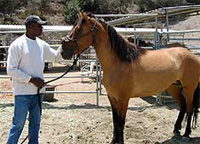 |
Local Horseman Steve Boyles Selected
to Compete in Mustang Challenge
Challenge contestants train wild horses
for a purse of $7,500 |
Steve Boyles of Santa Clarita California, has been selected by the Mustang Heritage Foundation to compete in the Western States Horse Expo Mustang Challenge June 6-9 in Sacramento, California. Trainers selected from applicants across the nation were invited to compete in the competition following a rigorous application and selection process which narrowed the field to a total of 34 horsemen who will have 100 days to gentle an American Mustang. Trainers scheduled to pick up their horses that were preselected on March 6-8 in Sacramento, California.
“The success of the Extreme Mustang Makeover in Texas, along with a heightened awareness of the value of these unique horses, caused the birth of the Challenge events as so many people wanted to see how these trainers worked with these Mustangs,” said Mustang Heritage Foundation Executive Director Patti Colbert.
About Steve Boyles
Steve’s love for mustangs began in the early ‘90s when he attended a Bureau of Land Management Wild Horse and Burro Adoption at the Los Angeles Equestrian Center. He was immediately captivated by the sight of the mustangs. Even crowded in their sales pens, the horses struck Boyles as something special. “I liked the spirit they had,” he said. Boyles was so taken with these wild horses that he adopted his first two mustangs at the sale. Since then, he has been committed to rescue and adoption efforts and and is typically recommended by the BLM to transport and train wild horses.
Boyles credits his experiences with wild horses with enriching his overall understanding of horse behavior. According to Boyles, getting a mustang to approach a person and allow itself to be handled takes patience and perseverance, but the rewards are well worth the effort. “Finding the horse’s aura, his energy, and blending your energy with his......it’s an amazing thing once you do it”. -About Steve Boyles by Mari Fukuyama
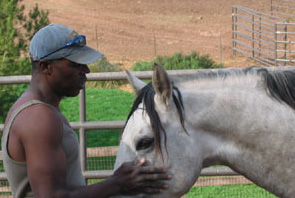
About the Chanllenge
During competition, trainers will be evaluated on the body condition of their American Mustangs, as well as their ability to handle the horse “in hand” through a series of maneuvers which include picking up the horse’s feet, maneuvering it through obstacles and loading it into a trailer. Following the “in hand” course, trainers will mount their animals and complete a “horse course” that will include a series of obstacles and require the trainer to demonstrate the level of competency the horse has accomplished. Three skilled horsemen, including well-known clinician and speaker, John Lyons of Parachute, Colo, will judge trainers.
The public will be invited to participate in adopting one of the Mustang Challenge competition animals June 9. Even though the animals will have been handled and trained, the same conditions will apply for the new owner when the animal is adopted.
Potential adopters will apply for the opportunity to be included in the competitive bidding process at the event with BLM personnel available to review and approve the application on site. In order to apply, applicants must be at least 18 years old, have no prior conviction for inhumane treatment of animals or violations of the Wild Free-Roaming Horse and Burro Act and be able to demonstrate that adequate food, water, and facilities will be available to humanely care for the animal. Specific facility requirements pertain to type and height of enclosed space, as well as shelter from the elements.
The Mustang Heritage Foundation (MHF), in partnership with the US Bureau of Land Management (BLM), created the Mustang Challenge event to highlight the recognized value of mustangs through a national training competition. The Challenge events are the progeny of the highly successful Extreme Mustang Makeover first held in September 2007. The 2008 event, to be held September 18-21in Fort Worth, Texas, offers a purse of $50,000 and 200 horses. The purpose of the Mustang competition series is to showcase the beauty, versatility, and trainability of these rugged horses that roam freely on public lands throughout the West, where they are protected by the BLM under Federal law. One hundred percent of the horses place for adoption at the 2007 Extreme Mustang Makeover were adopted.
The Western States Horse Expo is the largest and most comprehensive equine exposition and trade show in North America. Created to bring together horse enthusiasts and the businesses that serve them, the Expo has evolved into a three-day extravaganza serving the interests of every type of horseman in an entertaining and informative atmosphere. Since 1999, the Western States Horse Expo has attracted a half million equestrian enthusiasts and industry professions from around the world.
About the Mustangs
The mustangs selected for the Western States Mustang Challenge are from an area known as the Coppersmith Herd Management Area (HMA). This area lies 30 miles southwest of Cedarville, CA in Lassen County, California and Washoe County, Nevada. This area is comprised of approximately 70,500 acres. This HMA has an Appropriate Management Level (AML) of 75 wild horses with a range of 50-75 animals. This area contains horses thought to originate from Spanish stock diluted with ranch stock and US Cavalry remounts prior to and during World War I. Many of the horses in this area have characteristics common to Morgans and Quarter Horses. Predominant colors are bay,
black, and brown.
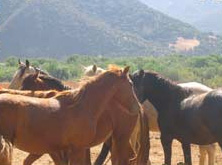
About the Mustang Heritage Foundation
The mission of the Mustang Heritage Foundation and the goal of the Extreme Mustang Makeover are to increase the adoption of mustangs across the country. The Mustang Heritage Foundation created the Extreme Mustang Makeover event to showcase the recognized value of mustangs through a national training competition.
About the Bureau of Land Management
The Bureau of Land Management (BLM) is responsible for managing 258 million acres of public lands, located mostly in the West. Wild horses and burros roaming public rang elands are managed in a manner consistent with BLM’s overall multiple-use mission, as set forthe in the Federal Land Policy and Management Act of 1976. Since 1973, the BLM has place more than 219,000 horses and burros into private care through adoption. For more information, visit wildhorsesandburro.blm.gov or call 866-4MUSATANGS.
VISIT STEVE AND HIS MUSTANG AT:
WWW.STEVEBOYLESHORSEMANSHIP.COM |
|
| ~ March 27, 2008 ~ |
It Could Happen To You
By Marta Zarrella
Mpzarrella@gmail.com |
 |
Colic, lameness, and the price of hay, those are the normal concerns for all of us who own horses. Theft is not generally in the forefront of our horse related thinking. However, theft, especially during tough economic times, should be of concern to every horse owner.
Recently, a young trainer arrived at work in a well-kept, clean, supervised facility to find her horse trailer missing. The horses were where they were supposed to be; her trailer had been safely parked in the lot along with many other trailers when she went home on Sunday. When she came back to work on Tuesday, the trailer was not there. A confident someone helped themselves to the trailer and everything that was stored in it. This was a crime of opportunity executed brilliantly by someone who knew what they were doing. The trailer was taken from a well-lit, fenced, gated, monitored facility with people probably mulling about as they often do on a beautiful Sunday afternoon. Researching this story, I read a report of a horse trailer taken from a driveway at someone’s home while the owner was inside the house. The owner, according to the report, stepped in momentarily. The driveway theft was in Riverside County, the barn parking area theft was in San Diego County. In tough economic times, desperate people do desperate things. Any one of us at any time in any place is susceptible to theft. Our horses, tack, equipment, trucks and trailers are not immune. There is a market for everything of value.
Crime Prevention Specialist Darlene Duncan of the Poway Sherriff’s department recommends that we have several layers of security to protect our assets, especially as absentee owners in situations like a boarding stable or a horse show. “Unfortunately, gated communities or a small town feel create a false sense of security.” Even if a facility has gates and access points which are monitored, it is our responsibility to secure and label our belongings. How often do we leave our trailers unlocked and our horses tied to them at horse shows? The editor of this website, told me of a situation where a truck was stolen at a horse show with all the owner’s English tack and attire. The truck without trailer was parked amongst the trailers. Stolen while several people in their group were preparing for classes in the general vicinity. |
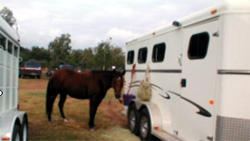 Autumn hanging out alone at a show... Autumn hanging out alone at a show...
Notice key in trailer door. |
Times are tough; we cannot feel confident and safe even in a familiar place. That mentality is what thieves look for. The more layers of protection we have, the less likely a thief will put forth the effort required to steal. Most property crimes are crimes of opportunity. |
Layers of protection at an equestrian facility could be motion sensing lights, fences, monitored access, and locks. Keep a lock on your trailer; lock your tack room door. Do not keep your tack trunks out in the open; put them away behind lock and key. After lights and locks, labels are important. Specialist Duncan recommends engraving a unique identifying number on all of your things, preferably in two different locations, such at the cantle of your saddle or the hitch of your trailer. Engrave that same number in some hidden location also, the flap or fender of the saddle perhaps and the underside of your trailer. The young trailer would agree with that advice since everything labeled with her name was inside her stripped trailer dumped in a field. Things she had not labeled, like her tires, were gone.
Take pictures of your things, especially the expensive ones. Include a good photo of that identifying number. Because of identity theft, do not use your social security number or even your driver’s license number. Come up with a unique number or brand and make sure it is clear in the photographs you take. Specialist Duncan recommends that every facility where groups of people keep their horses and equipment should implement a neighborhood watch. Any law enforcement group would be very happy to come help a barn organize a neighborhood watch program. Through the Neighborhood watch programs, barns can build a relationship with law enforcement also. A “neighborhood watch” sign on entry gates adds another layer of protection.
So, how do we protect the most valuable asset, our horses? Dr Daniel Ohman, of East County Large Animal Practice in El Cajon, said horses are as much a target of theft in tough economic times as any other valuable object would be. However, how practical is it to lock them in their stalls? In case of fire or other emergencies, keeping horses safe by locking is not practical, safe or smart. There are better ways, the most simple of which is to have a record book for each horse. In that book, keep a record of medical treatment especially procedures that could leave a scar, document height, weight, markings anything that will help identify your animal. Keep a current photo of your horse, clearly showing all those identifying marks, cowlicks, scars, etc.
Microchipping and registering the chip is a very affordable and effective option. The microchip, a digital transponder the size of a grain of rice, is inserted by a veterinarian into the horse’s neck. The chip carries a unique number that is registered along with the animal’s details. A scanner is able to read and display the number allowing the horse to be identified when lost or stolen. Dr Ohman noted that during the 2007 Wildfires, horses were routinely scanned for microchips at evacuation facilities. Because of that, owners were reunited with their horses much sooner, on average, than during the 2003 wildfires.
Owners can opt to have the identifying number from the chip also freeze branded on the horses neck, giving potential thieves a more obvious deterrent. Tattooing, as is done on racing horses, is another more complicated and expensive option for horse owners. Freeze branding leaves a permanent white brand, which can be unattractive. Tags on stalls or halters noting that an animal is microchipped might be enough of a deterrent, along with the lights, gates, locks and vigilance.
Speaking of vigilance, the tale of the stolen trailer in San Diego has a somewhat successful conclusion. On Tuesday, when the young trainer noticed that her trailer was not where she left it, she sent an email alert out to her friends, fellow trainers and clients. The notice was in my inbox four times - the Horse Community rallied. By the time an abandoned, stripped trailer was seen dumped in a field and reported to law enforcement word was out all over San Diego county. The deputy who found the trailer contacted local trailer shops in his effort to find the owner. That was all the deputy needed, the tight knit horse community knew who the trailer belonged to. Even before law enforcement took a report from the owner, the trailer had been found thanks to the close connections within our horse community.
GOOD JOB, HORSE PEOPLE!!! |
|
| ~ March 12, 2008 ~ |
 |
Beware of Horse Buying Scams |
| The Federal Trade Commission reports that "check overpayment" scams are the fourth most common scam on the internet today. Typically, the person you are doing business with sends you a check for the price of a horse advertised online that is more than the amount they owe you. They tell you to deposit the check, keep part of the amount for your own compensation, and then wire the rest to a shipper. The results are the same: the check eventually bounces and you are stuck, responsible for the full amount, including what you wired to the scammer. The FTC offers the following tips for avoiding the check overpayment scam: |
• |
Know who you are dealing with-independently confirm your buyer's name, street address, and telephone number. |
• |
If you are selling something over the Internet, say "no" to a check for more than your selling price, no matter how tempting the plea or convincing the story. |
• |
There is no legitimate reason for someone who is giving you money to ask you to wire money back. |
| More advice about how to be on guard against Internet fraud is available at OnGuardOnline.gov. Consumers are asked to report check overpayment scams to their state Attorney General, the National Fraud Information Center/Internet Fraud Watch, a service of the National Consumers League at www.fraud.org or 1-800-876-7060, or the FTC at www.ftc.gov or 1-877-FTC-HELP. |
| SoCalEquine.com thanks the AHA Broadcast E-News for this article. You can visit the Arabian Horse Association online at www.arabianhorses.org. |
|
| ~ March 4, 2008 ~ |
LOOKING FOR A FEW GOOD HORSES!
The Intercollegiate Horse Show Association is seeking horses for use at the 2008 IHSA National Championship Horse Show
to be held May 8-11, 2008
at the Los Angeles Equestrian Center in Burbank, CA. |
 |
| What is the Intercollegiate Horse Show Association? |
• |
The IHSA is a non-profit organization established in 1967 as a way for college students to ride and exhibit horses even if they do not own a horse. |
• |
More than 350 colleges and universities, located in 45 states and Canada, are IHSA member schools. Over 6500 riders compete each year in IHSA-sanctioned events. |
• |
Major sponsors include the United States Equestrian Federation, the American Quarter Horse Association and the National Reining Horse Association. |
 |
| How do riders qualify for the National Championship Show? |
• |
Individual riders accumulate points at IHSA-sanctioned shows to qualify for the Regional Finals. The top two riders in each division at the Regional Finals advance to the Zone Finals. The top two riders in each division at the Zone Finals qualify for the National Championship Horse Show ("Nationals"). Additionally, the top Hunt Seat and Western teams from each of the nine zones compete for National Champion Team honors. |
• |
The riders who qualify for Nationals are part of an elite group. Only the top 18 IHSA riders in each division are allowed to compete at Nationals. |
• |
General information about the IHSA and the 2008 IHSA National Championship Show may be found on the official IHSA website, http://www.ihsainc.com. |
 |
| Why do we need to borrow horses for use at Nationals? |
| • |
The IHSA was founded on the principle that any college student should be able to participate in horse shows, regardless of his or her financial status or riding level. |
| • |
Students ride horses that are furnished by the host school and chosen by drawing lots. Use of students' personal tack is not allowed and schooling is not permitted. This structure equalizes the economic variables typically found in equine competition and provides a true test of the riders' abilities. |
| • |
Given the size and prestige of the National show, it is impossible for the host colleges to provide all of the horses needed for the show. Therefore, we rely on the generosity of local horse owners to donate use of their equines for the National Championship Show. |
| For more information or to donate use of a horse, please contact Jen Earles at 951-675-1763 and email jdearles@csupomona.edu. |
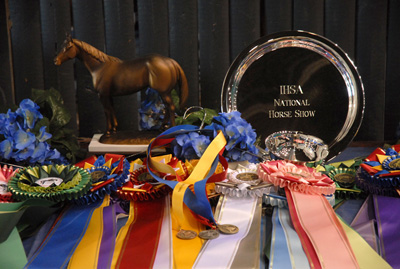 |
|
| ~ February 28, 2008 ~ |
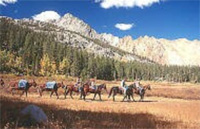 |
BACKCOUNTRY HORSEMEN OF CALIFORNIA SCHEDULES MAJOR RENDEZVOUS,
MARCH 21 – 23 IN TURLOCK. |
Two centuries ago, mountain men gathered twice each year at a rendezvous to swap lies and buy supplies for their treks to the backcountry. Today, the Backcountry Horsemen of California members and horse and mule enthusiasts all over the state meet for three days in Turlock, California to do almost the same things.
Since 1988, the Backcountry Horsemen of California’s Rendezvous has evolved into California’s biggest equestrian event focusing the backcountry and front country trails. This year’s statewide event will be held at the Stanislaus County Fairgrounds in Turlock on March 21, 22 and 23.
For pack veterans or newbees and anyone curious about trail riding and packing into the wilderness, Rendezvous offers an array of activities packed into three full days, all in the interest of bringing horse lovers and the wilderness together.
At Rendezvous, you can check out the scores of horse equipment vendors, sample gourmet Dutch oven cooking, learn from the top experts about Gentle Use, Leave No Trace and packing dos and don’ts, enjoy demonstrations and exhibitions, and totally immerse yourself in the world of backcountry and front country trail riding.
Even if you usually limit your riding to the front country – established trails in regional and state parks – you will learn something valuable at Rendezvous. Joe Peacock will present workshops on natural barefoot hoof trimming, Jim Bell will teach about map reading and GPS for the backcountry, Garry Stauber will do a program on long riding, and Martha McNeil will teach about miniature horses for kids. Jo Johnson, Carol Jo Hargreaves, and Peter Kriger will present workshops on de-sensitizing and preparing the pack animal. More workshops and clinics are being planned.
Besides the clinics, Rendezvous participants can attend classes on Gentle Use, participate in contests for awards, and enjoy catered banquets in the evening.
They also can shop for all their horse-related needs, from top-quality hats to endurance equipment to trail guide books. This year’s Rendezvous features a new enlarged show of art works about the West.
And on Sunday, participants can attend a special Cowboy Church for Easter morning.
Whether towing a string of pack stock, or riding alone on a sweet single-track trail, riding the backcountry and front country beckons. Come to Rendezvous 2008 and get hooked.
For information and reservations, contact Chip Herzig @ 951-769-3781 or John Black @ 209-537-1516. And check out the Web site, www.bchcalifornia.net. |
|
| ~ February 19, 2008 ~ |
 |
No Kidding! John Pearce and his mount Archie Bunker win the $50,000 Purina Mills Grand Prix at HITS Thermal |
THERMAL, CA (February 11, 2008)- Canadian Olympian John Pearce negotiated the fastest double-clear round aboard Archie Bunker to secure the top prize in Sunday's $50,000 Purina Mills Grand Prix to conclude a very exciting week of show jumping at HITS Thermal.
Pearce collected $15,000 in prize money as he outlasted 43 combinations in the first round and 10 pairs in the jump-off. Pearce was fourth to go in course designer Anthony D'Ambrosio's jump-off course and set the Great American time to beat at a lightning fast 37.20.
The jump-off featured four clear rounds, including Mandy Porter and Summer who followed Pearce and Archie Bunker in the order. They navigated the course without dropping any rails and stopped the clocks in 39.09. That time was good enough for second place as Pearce was nearly two seconds faster than any other competitor in the round.
"I was feeling it today," said Pearce. "I knew with ten in the jump-off I had to be fast and clean. So, I went into the ring, didn't hold anything back and won some great prize money for the second week in a row!"
Pearce has been cashing in as last Sunday in the $125,000 HITS Grand Prix, presented by EMO he was second aboard Archie Bunker and sixth aboard Chianto collecting a total of $33,750 in prize money for the day.
Jill Henselwood was eighth to go in the jump-off aboard Stacie Ryan's Black Ice . The Pan Am Games Gold Medal winner had her first double-clear round of the circuit and stopped the clocks in 39.60 to finish in third place. Henselwood is just getting warm, as she had the flu and missed the first couple of weeks of competition.
Following Henselwood was Jill Humphrey and her mount Lou Bega . The pair posted a clear round in 42.00 to finish in fourth place for Equistar, LLC. Humphrey finished the class with three horses in the money.
Rounding out the top five were Richard Spooner and his mount Cristallo , who had the fastest time of those with four faults in the jump-off. They stopped the clocks in 38.26 to secure $3,000 in prize money for Show Jumping Syndication.
With the win, Pearce also earned some valuable points towards the $200,000 Invitational Grand Prix to be held on Sunday, March 16 during the all new Championship Week at HITS Thermal. The top 30 pairs based on prize money won on the 2008 HITS Desert Circuit will be invited to compete in the class.
"The quality of show jumping here compares to some of the best I have seen anywhere in the world," said Pearce. "This place is nothing short of exceptional and I am proud to show my horses here."
"Its been great couple of weeks," said Porter, who competed at DC II and DC III. "HITS has really stepped up this year and has done some great things. The footing in the Grand Prix ring is excellent as well as all of the other jumper rings. I am thrilled with the facility!"
Porter also continued to praise the VIP Oasis Club. VIP Chef Ric Orlando has brought a unique dining experience to the VIP Oasis Club at the 2008 HITS Desert Circuit. "It is a fantastic place to be," said Porter. "Concierge Michael D'Ambrosio truly makes you feel like a VIP. Plus, the food is amazing!"
DC II also featured several run out-of-ring activates, including the first-ever HITS Thermal Equine Idol held on Saturday night. Hundreds watched as more than 30 exhibitors dueled it out for fantastic prizes donated by the generous vendors at HITS Thermal. The judges for the contest were Mark "Randy Jackson" Bone of Huntover Farm, John "Simon Cowell" French of Waldenbrook Farm and Kathy "Paula Adbul" Hobstetter of ShowBiz Magazine.
On Sunday, the ever-popular Kids Day returned to HITS Thermal and featured an afternoon filled with family fun, including a very special Grand Prix rider autograph session after the $50,000 Purina Mills Grand Prix. Among the gracious riders who participated were Pearce, Porter, Ashlee Bond and Thursday's winner of the $25,000 Ariat Grand Prix, Kim Farlinger.
The Purina Mills trailer was also on hand for Kids Day and gave out temporary tattoos to the children. They also sponsored the HITS Thermal Equine Idol as well as being the title sponsor of the Sunday Grand Prix. "It was a great weekend for Purina Mills," said Marketing Director Nancy Shearer. "We are thrilled to be associated with all of the HITS horse shows."
In other action at HITS Thermal during DC III, Catie Verano secured the Central Equine Junior Medal and John French of Gilroy, California rode Obelix to the Adequan Hunter Championship to highlight an exciting week of competition. For more information on Central Equine please visit www.centralequine.com , and for more information on Adequan please visit www.HitsShows.com/press/pdf/adequan.pdf.
The HITS Desert Circuit now takes a one-week hiatus. Then competition at HITS Thermal returns on Tuesday, February 19 for four consecutive weeks of shows and runs until Sunday, March 16 when the new Desert Circuit Championship will close out the season with 17 different championship classes, including the R.W. Mutch Equitation Classic and the first-ever $200,000 Invitational Grand Prix of the Desert.
HITS, Inc. is a special events management company primarily focused on producing hunter/jumper horse shows. Based in upstate New York in the village of Saugerties, HITS produced its first horse show circuit in Gainesville, Florida in 1982. Since that time, HITS has grown into a nationwide company with world-class hunter/jumper circuits in California, Florida, Arizona, New York and Virginia.
For more information and a complete schedule of classes and events, visit www.HitsShows.com
Media should contact Chris Mayone at 845.246.8833 or e-mail Media_Info@HitsShows.com
HITS Thermal (DC III) Video Courtesy of Show Jumping Unplugged

©Flying Horse Photography
John Pearce and Archie Bunker win the $50,000 Purina Mills Grand Prix at HITS Thermal

©Flying Horse Photography
HITS' Senior Vice President Tony Hitchcock and representatives from Purina Mills congratulate John Pearce and Archie Bunker at HITS Thermal |
Placing |
Horse |
Rider |
Owner |
Prize
Money |
Rd
1 Faults |
JO
Faults |
JO
Time |
1 |
Archie
Bunker |
John
Pearce |
Allison
Moore |
$15,000 |
0 |
0 |
37.209 |
2 |
Summer |
Mandy
Porter |
Wild
Turkey Farm |
$11,000 |
0 |
0 |
39.097
|
3 |
Black
Ice |
Jill
Henselwood |
Stacie
Ryan |
$6,500 |
0 |
0 |
39.604 |
4 |
Lou
Bega |
Jill
Humphrey |
Equistar
LLC |
$4,000 |
0 |
0 |
42.003 |
5 |
Cristallo |
Richard
Spooner |
Show
Jumping Syndication |
$3,000 |
0 |
4 |
38.267 |
6 |
Chianto |
John
Pearce |
Alison
Moore |
$2,500 |
0 |
4 |
38.486 |
7 |
Chivas
Z |
Ashlee
Bond |
Little
Valley Farm |
$2,000 |
0 |
4 |
41.275 |
8 |
Sulleyman
De Wulf Selection |
Guillermo
Obligado |
Adria
L Mashburn |
$1,500 |
0 |
4 |
41.349 |
9 |
Rockford
I |
Keri
Potter |
Keri
Potter |
$1,500 |
0 |
5 |
50.902 |
10 |
Felix
380 |
Jill
Humphrey |
Equistar
LLC |
$1,000 |
0 |
16 |
45.164 |
11 |
Kaskaya |
Jill
Humphrey |
Leone
Equestrian |
$1,000 |
4 |
|
|
12 |
Kasoar
D' Uxelles |
Laura
Teodori |
L&M
Ventures |
$1,000 |
4 |
|
|
|
HITS CORPORATE OFFICE: HITS, Inc., 319 Main Street, Saugerties, NY 12477-1330
phone 845.246.8833 fax 845.246.6371 www.HitsShows.com |
|
| ~ January 21, 2008 ~ |
Update on the Silverlakes / Belstarr Proposal in Norco
by Peggy Hosking |
| Last night (January 16th) the Memorandum of Understanding between Belstarr Sports Management LLC and the City of Norco was brought before the Norco City Council for approval. After a detailed and thorough presentation by the real estate consultant for the parties, the floor was opened for public comment and the residents of Norco and representatives of the Parks & rec commission, RURAL, Norco Horseman's Association and the Norco Conservancy expressed their appreciation for what one man called "an Equestrian Disneyland." |
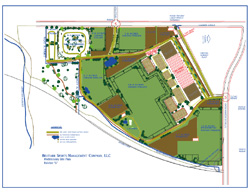 |
After public comment concluded, Norco City Council voted unanimously to approve the MOU. The MOU will essentially govern the relationship between Norco and Belstarr Sports Management, LLC over the next 18 months or sooner if certain benchmarks are reached. |
| Now that the MOU is in place, a due diligence period of investigation will begin. During this period, which expires April 30, 2008, the developer (Belstarr) can conduct environmental and other investigations on the property to determine what, if any, environmental clean up or other "problem solving" is required. Concurrently, an Environmental Impact Report will be generated and the CEQA process will begin. The CEQA process may likely be the longest portion of the investigation and approval process. Realistically, it could take 18 months. However, all consultants, the City and Belstarr are optomistic that a more aggressive target of October 2008 will be realized. While all of the environmental reports are being generated, the City and Belstarr will continue to negotiate the details of the final agreement. The final agreement will go into more specifics - size of arenas, type of footing, size and type of buildings, access points, rates, availability to various community groups, etc. |
All of these activities are directed toward the aggressive goal of ground breaking by the end of the year (2008).
We certainly hope that the City, Belstarr and the Consultants are able to reach their goals by the end of 2008!
Margaret "Peggy" A. Hosking
Associate
Best Best & Krieger LLP
3750 University Avenue, Suite 400
P.O. Box 1028
Riverside, CA 92502
Phone: 951-826-8359
Fax: 951-686-3083
margaret.hosking@bbklaw.com |
|
| ~ January 14, 2008 ~ |
World Class Show Facility in Norco
by Peggy Hosking |
Last summer I asked you to write to Norco City Council and to attend a meeting to hear proposals for the 122 acre Silver Lakes parcel owned by the City of Norco. You guys were great; the City Council members were flooded with phone calls and e-mails, the meeting room was packed the night of the meeting and the City Council and Commissioners voted unanimously to enter into negotiations with Belstarr – a sister entity to Blenheim Equisports, the developer and promoter of the Oaks show facility in San Juan Capistrano. Since August, the City and Belstarr have been meeting to hammer out the details of their agreement which are memorialized in a “Memorandum of Understanding” or “MOU”.
On Wednesday, January 16, 2008, the MOU will be presented to the City for signature. This is a public meeting and all are welcome to attend.
The City Manager, Jeff Allred, sent me an e-mail to let us know about this agenda item. In the e-mail he said, "the Belstarr agreement to initiate the equestrian project at the Silverlakes property will be on the City Council agenda this coming Wednesday evening at 7:00 p.m. The meeting will be in the City Council Chambers behind City Hall. Belstarr is enthusiastic about proceeding. I'm hoping that you and some of your friends that support the project will be able to attend." |
 |
Here is a color conceptual overlay of Belstarr’s plan for the 122 acre "Silver Lakes" parcel in Norco (click for larger version). It looks like it will be a terrific show facility, park and staging area for trail rides in the riverbed. The MOU provides that the City will retain ownership of the property and will enter into a 50 year ground lease with Belstarr. Belstarr will pay rent to the City, develop the property and promote events. |
It is important to keep the momentum going with the City Council, Commissioners and Belstarr. Please plan to attend the meeting Wednesday, January 16, 2008 at 7 p.m. 2870 Clark Avenue, Norco, CA
Directions: From the 15 Freeway, Exit at SECOND STREET Go one block West (toward the car dealerships) to HAMNER AVENUE, turn right (north). Go to MARKET STREET (between Bank of America and State Bros. Markets), turn left. MARKET STREET ends in the annex parking lot. The Learning Center North is the building in the far right corner of the parking lot.
If you cannot attend, please write to our City Council Members to express your continued support of this project. (Please note, we have 2 new City Council Members who were not on the Council for the August Meeting, Berwin Hanna and Malcolm Miller)
Mayor, Frank Hall
fhall@ci.norco.ca.us
Mayor Pro Tem, Hal Clark
hclark@ci.norco.ca.us
City Council Member, Kathy Azevedo
kazevedo@ci.norco.ca.us
City Council Member, Berwin Hanna
bhanna@ci.norco.ca.us
City Council Member, Malcolm Miller
mmiller@ci.norco.ca.us
If you have any questions, please feel free to e-mail me.
Peggy Hosking
PeggyHosking@sbcglobal.net |
|
| ~ January 7, 2008 ~ |
HITS Thermal Grand Prix Footing Impresses USEF and West Coast Active Riders during Inspection for the 2008 Season
Riders and Management come together to ensure satisfaction |
 THERMAL, CA (December 13, 2007)--On Thursday, December 13, HITS, Inc. along with members from the West Coast Active Riders Association and representatives from USEF conducted a pre-season footing test at the new HITS Desert Horse Park in Thermal, California. THERMAL, CA (December 13, 2007)--On Thursday, December 13, HITS, Inc. along with members from the West Coast Active Riders Association and representatives from USEF conducted a pre-season footing test at the new HITS Desert Horse Park in Thermal, California.
Representing HITS was President and CEO Tom Struzzieri and Dale Harvey of the HITS West Coast Management Team. Bart Poels, footing specialist for the 2008 Olympic Games, who has been hired to oversee the footing at all HITS-owned properties throughout the United States, was at the property earlier in the week to ensure preparations were on track for the test. The new footing is comprised of a special blend of sand, geo-textile and fibers, similar to what Poels helped to install for the 2008 Olympic Games
The West Coast Active Riders were represented by Board Chairman Bernie Traurig, as well as WCAR President, Will Simpson of El Campeon Farms. Sally Ike, Managing Director of Show Jumping, represented USEF for the test.
Allen Rheinheimer was selected by USEF to participate in the test. Several West Coast riders also participated, including Simpson, Amanda Porter and Joie Gaitlin, to name a few.
"The test went great," said Rheinheimer. "We saw great results and found out just what we needed to know. With a little tweaking, HITS is moving forward in perfect condition. They've done a masterful job."
"I was confident that this test would demonstrate that any footing concerns are now behind us, and today we did just that," said Struzzieri. "Working together with the West Coast riding community has been an important part of our preparations for the 2008 season. We met in early spring to highlight our plans and goals, and agreed to reconnect prior to the start of the circuit for this purpose. I feel the collaboration worked, and I look forward to continuing the momentum we've started."
Traurig, who was part of the core group that met with HITS earlier in the year to outline some of the priorities for the 2008 season, had positive remarks about the footing and the process that brought riders to the facility in advance of the circuit. "After extensive testing, the footing at Thermal looks like it's going to be great," said Traurig. "Riders and Management both agree that with some tweaking, by adding fibers between now and the start of the circuit, the footing will get even better."
USEF's Managing Director of Show Jumping Sally Ike, who had visited the facility in November for a preview, was also impressed with what's been accomplished, not only with the footing but with other areas of the property as well. "One month later there has been incredible progress, and there is still more planned. Thermal is not just going to be good; it's going to be great!"
As High-Performance Liaison for the 2008 HITS Desert Circuit, Dale Harvey will be dedicated to ensuring the satisfaction of the Grand Prix riders at Thermal this coming season. "This certainly makes my job a lot easier, as satisfaction begins and ends with good footing. Once we have the same product on top of the EquiBase™ mats in the covered FEI ring, I'm confident that the World Cup riders will find that the conditions in Thermal will be superb for competition." Harvey went on to say that the footing in all the jumper rings will be similar to what was tested today in the Grand Prix ring.
Both the EquiBase matting and the EquiBase geo-textiles and fibers will be used in the covered FEI ring where the four World Cup Qualifiers will be held during the 2008 Desert Circuit. The FEI ring in Thermal will mark the second indoor installation in the United States, as EquiBase recently put the finishing touches on both indoor competition arenas at the DevonWood Equestrian Centre in Portland, Oregon.
HITS President and CEO Tom Struzzieri looks forward to welcoming exhibitors back to Thermal for the 2008 season. "I continue to feel proud of what we've accomplished here in Thermal," said Struzzieri. "Much effort has gone into preparing for the new season and we've made significant investments both financially and creatively to ensure that Thermal will exceed expectations."
The 2008 HITS Desert Circuit is set to get underway on Wednesday, January 9 with the Desert Circuit Premiere, the first of two new weeks added to the circuit. Tuesday, January 22 begins three consecutive weeks of shows, followed by an off week, February 11-17. Then HITS Thermal returns for four consecutive weeks of shows on Tuesday, February 19 and runs until Sunday, March 16 when the first-ever Desert Circuit Championship will close out the season with 17 different championship classes, including the $200,000 Invitational Grand Prix of the Desert.
HITS, Inc. is a special events management company primarily focused on producing hunter/jumper horse shows. Based in upstate New York in the village of Saugerties, HITS produced its first horse show circuit in Gainesville, Florida in 1982. Since that time, HITS has grown into a nationwide company with world-class hunter-jumper circuits in California, Florida, Arizona, New York and Virginia.
For more information and a complete schedule of classes and events, visit www.HitsShows.com
Media should contact Chris Mayone at 845.246.8833 or e-mail Media_Info@HitsShows.com |
HITS CORPORATE OFFICE: HITS, Inc.,
319 Main Street, Saugerties, NY 12477-1330
phone 845.246.8833
fax 845.246.6371
www.HitsShows.com |
|
|
| |
|
|